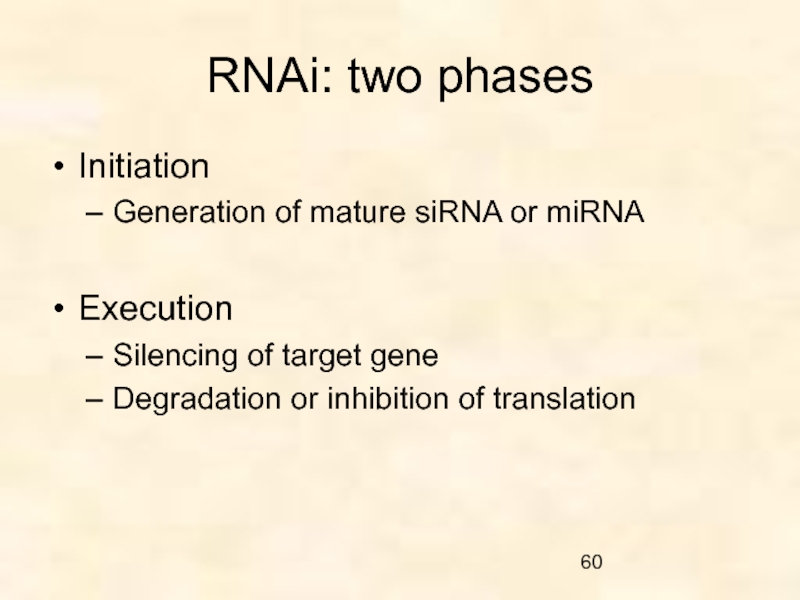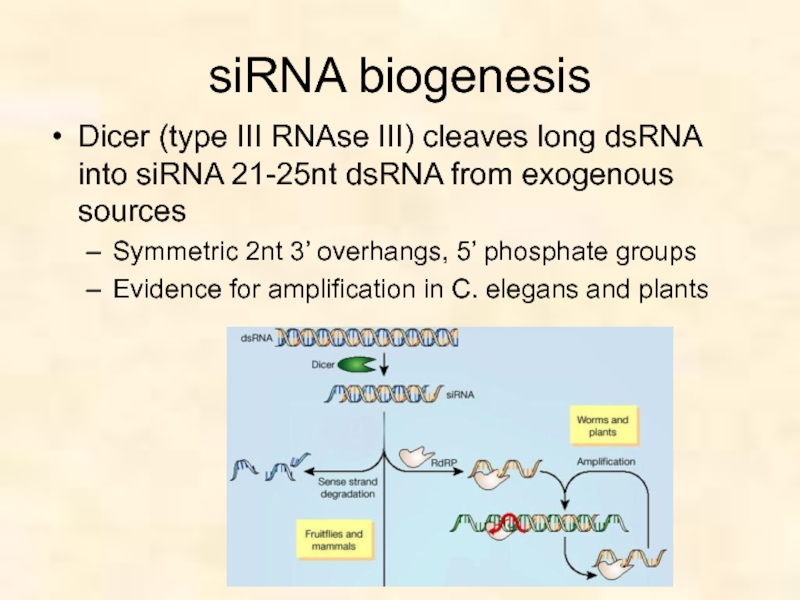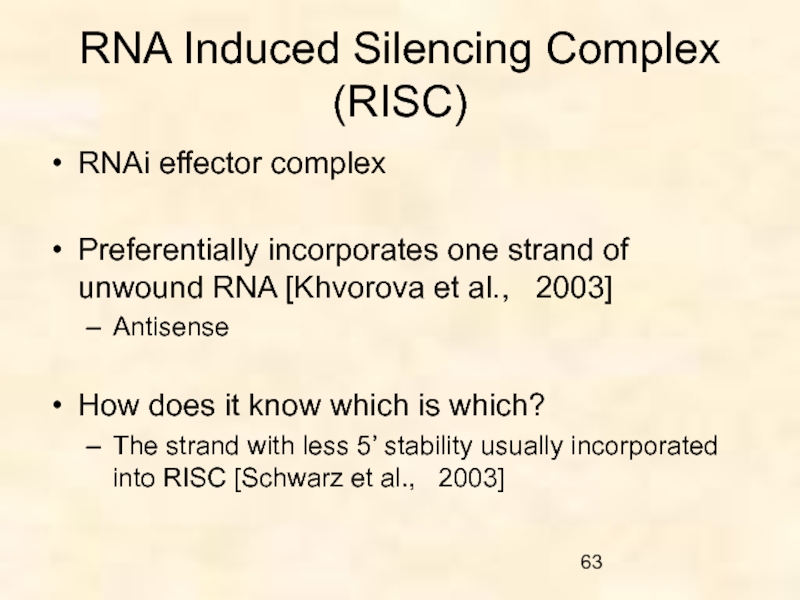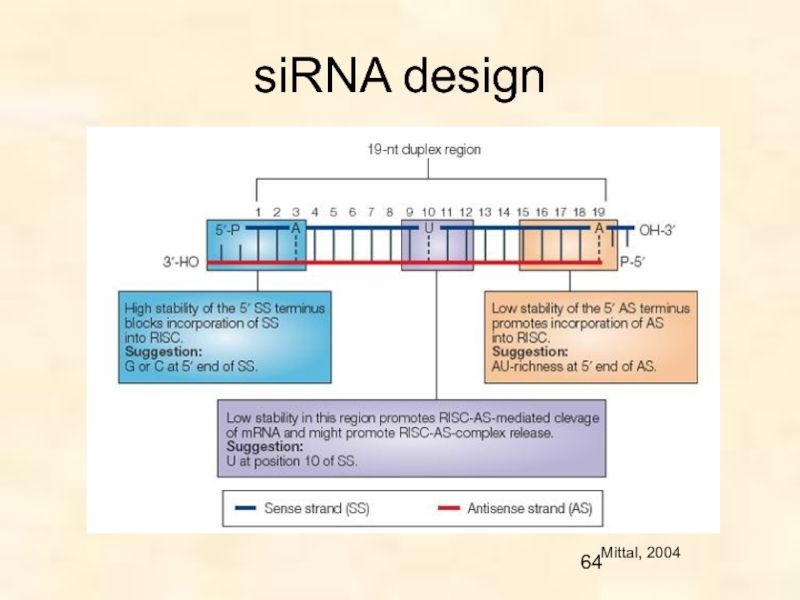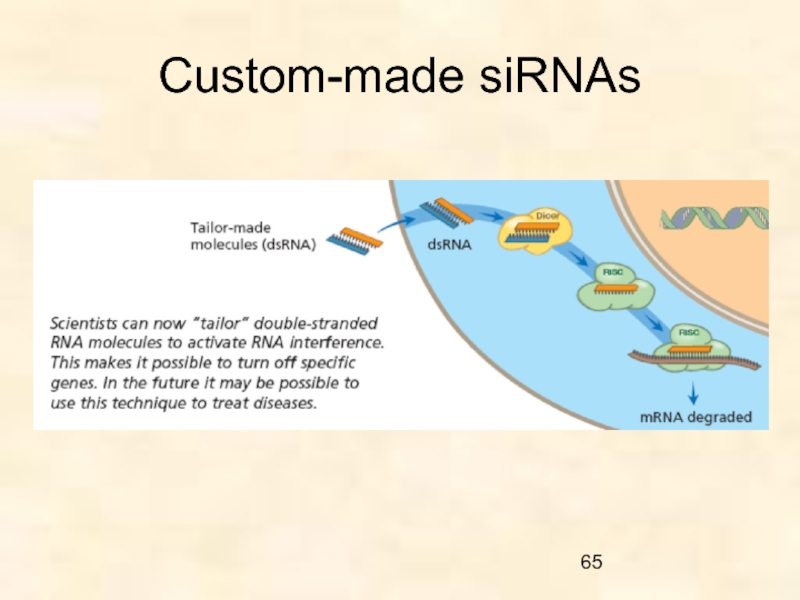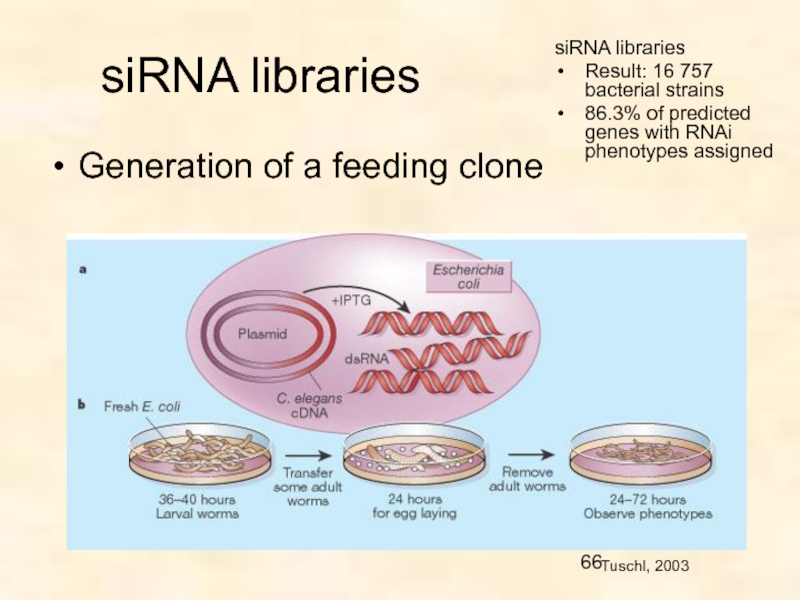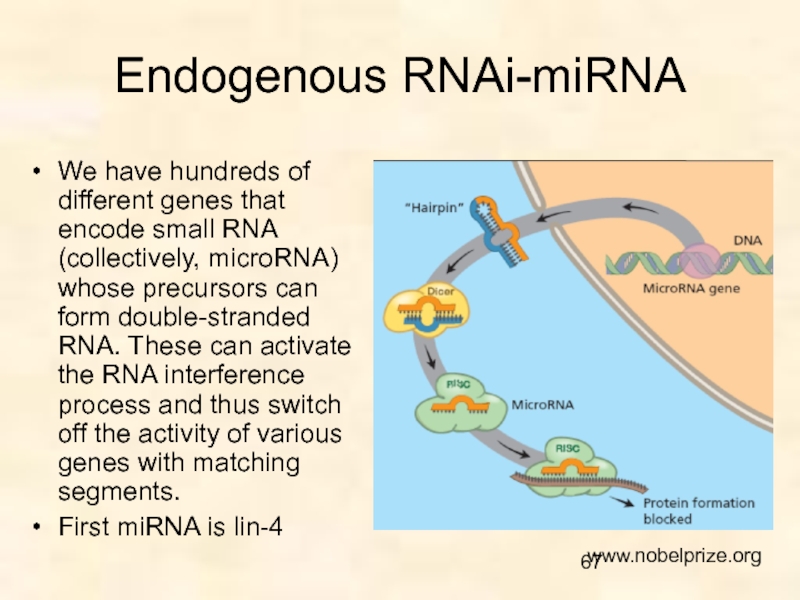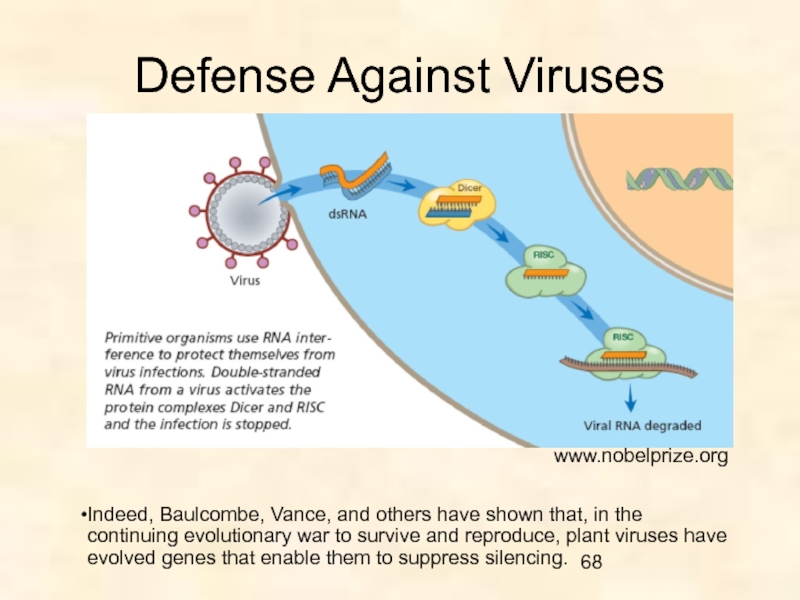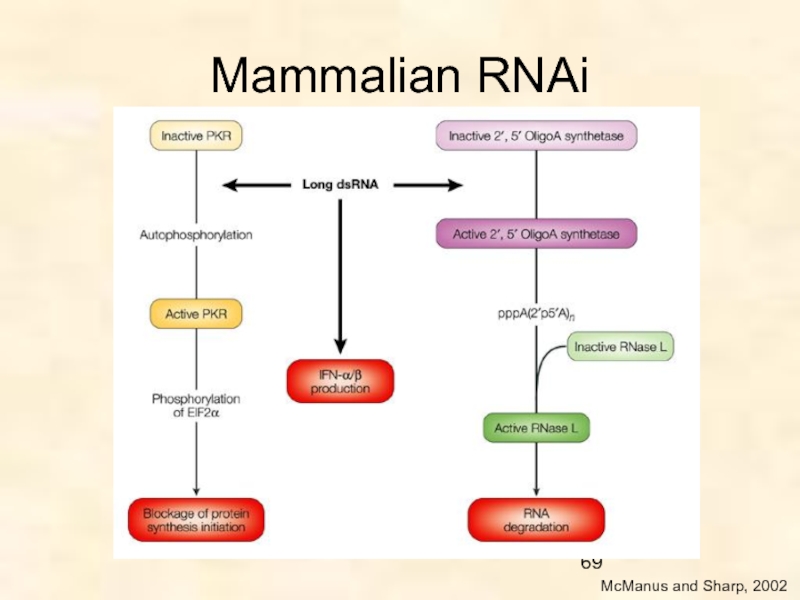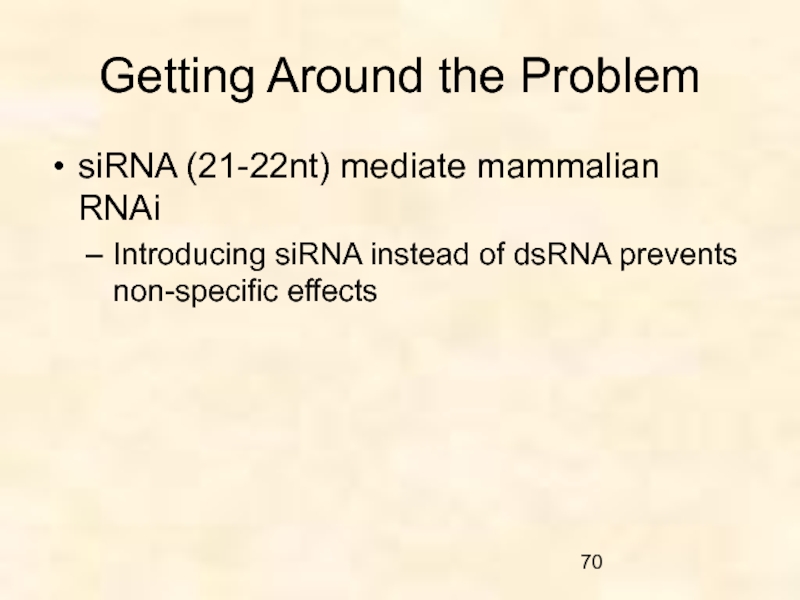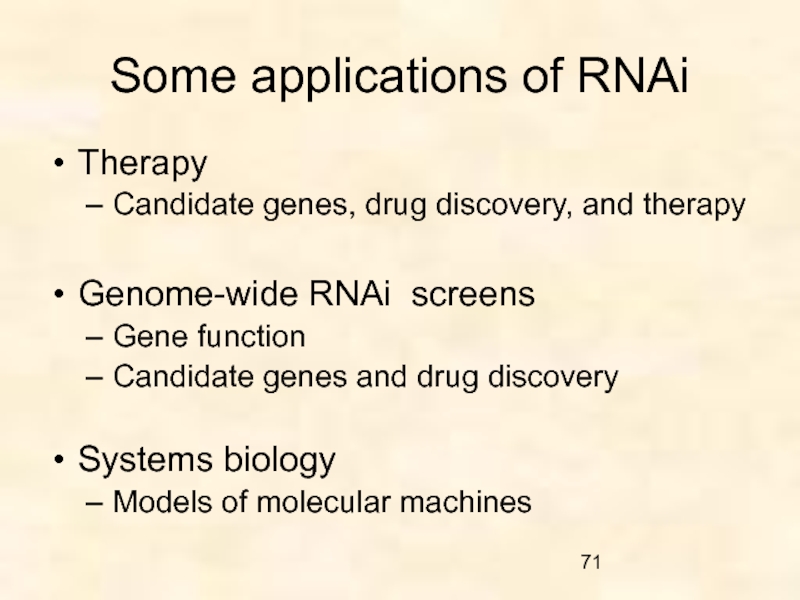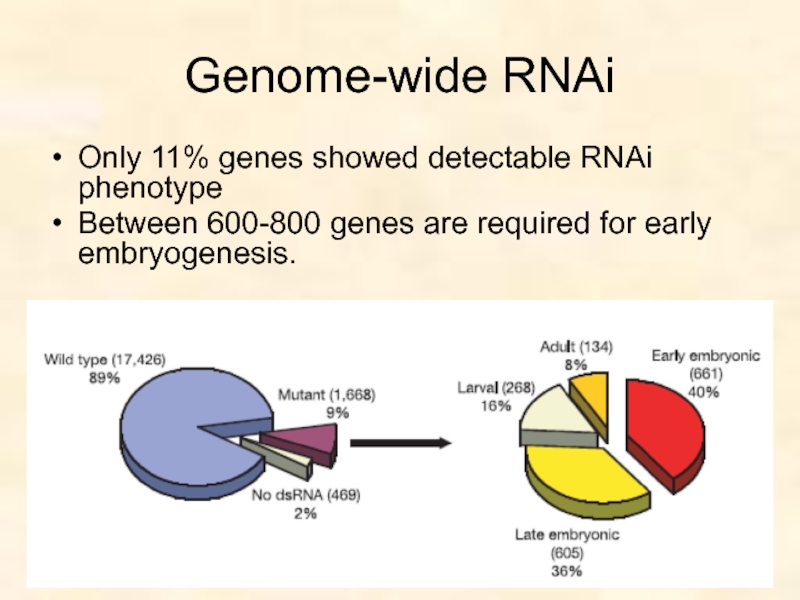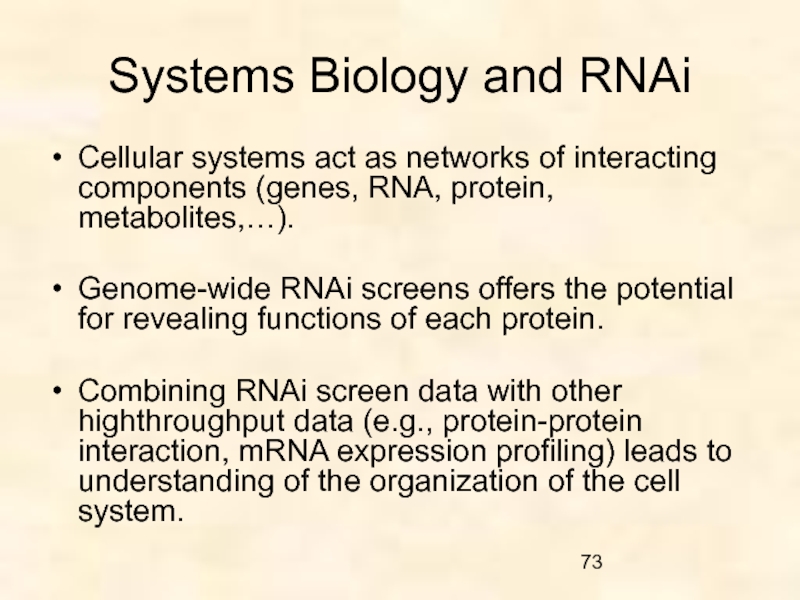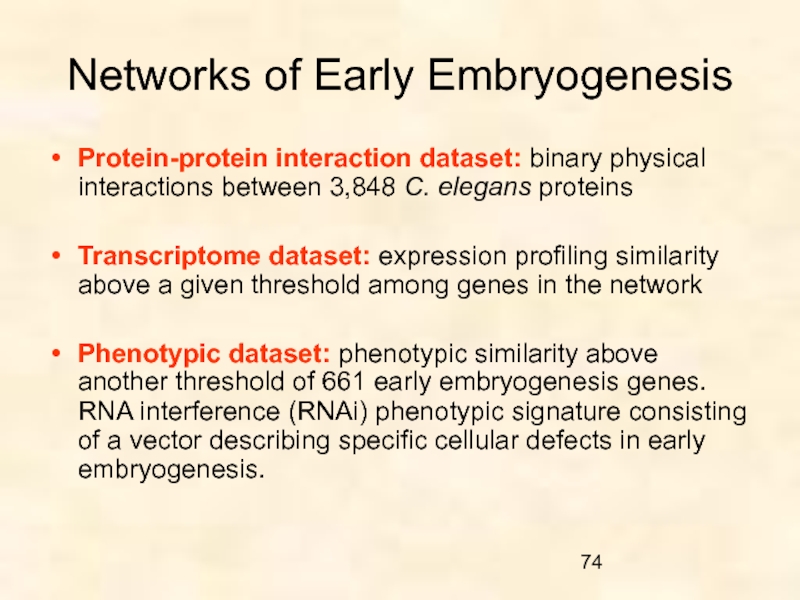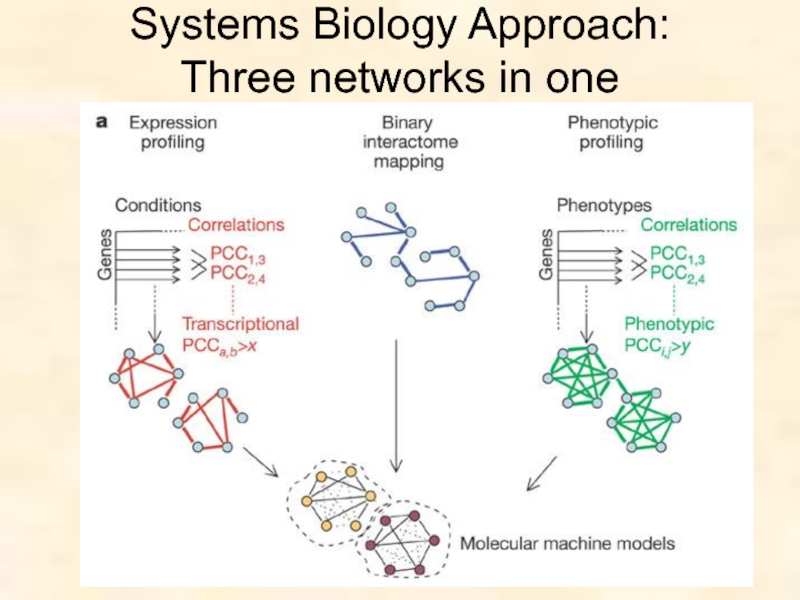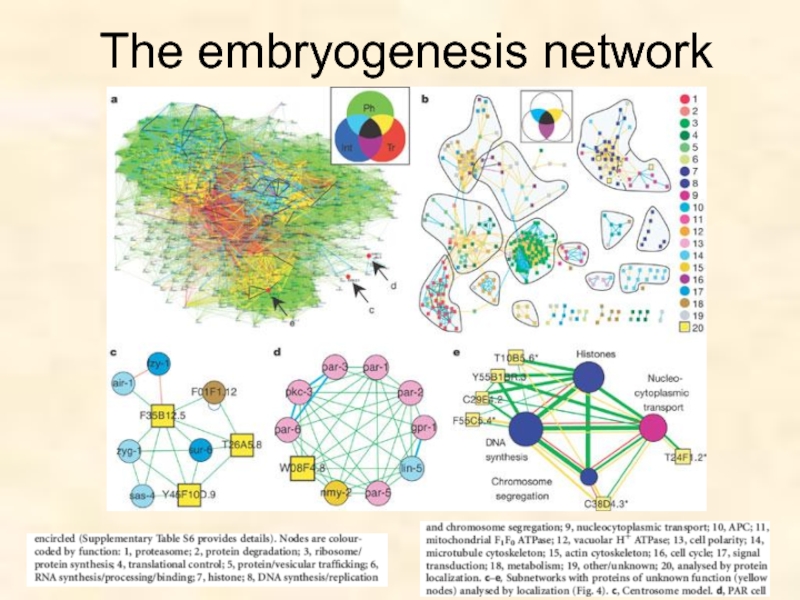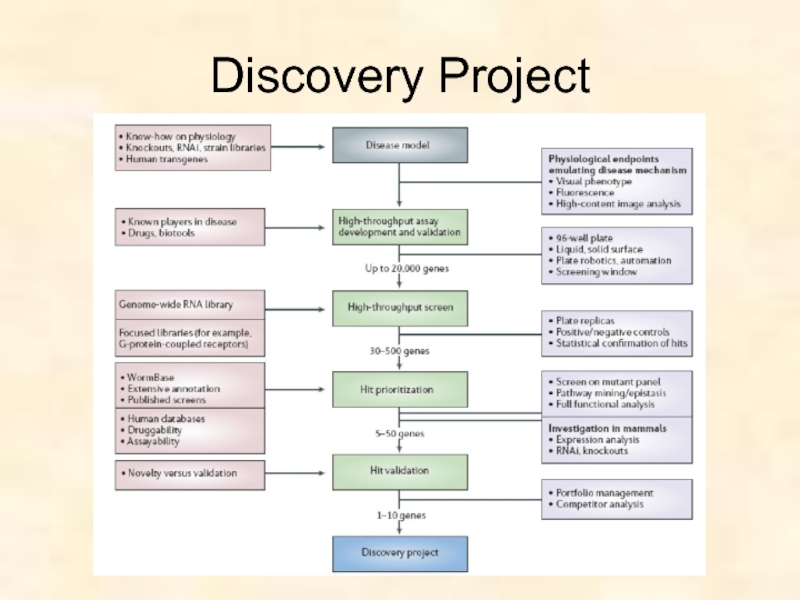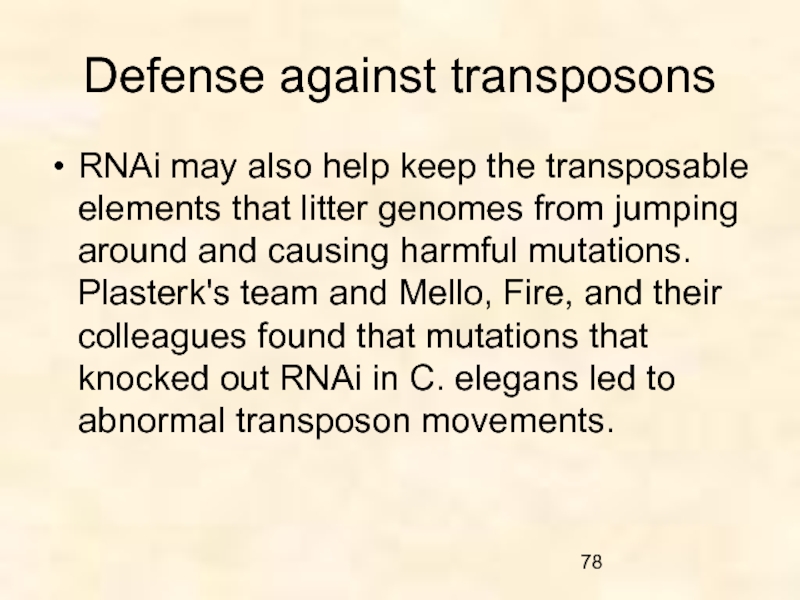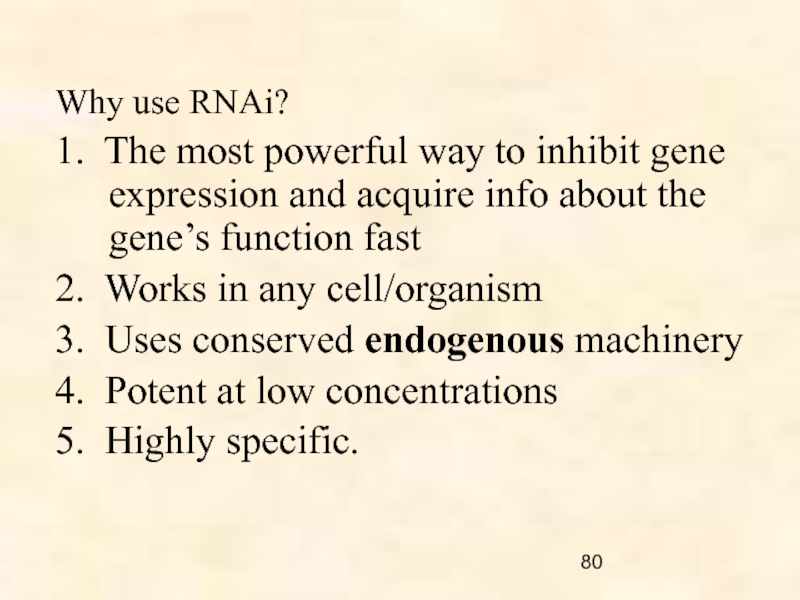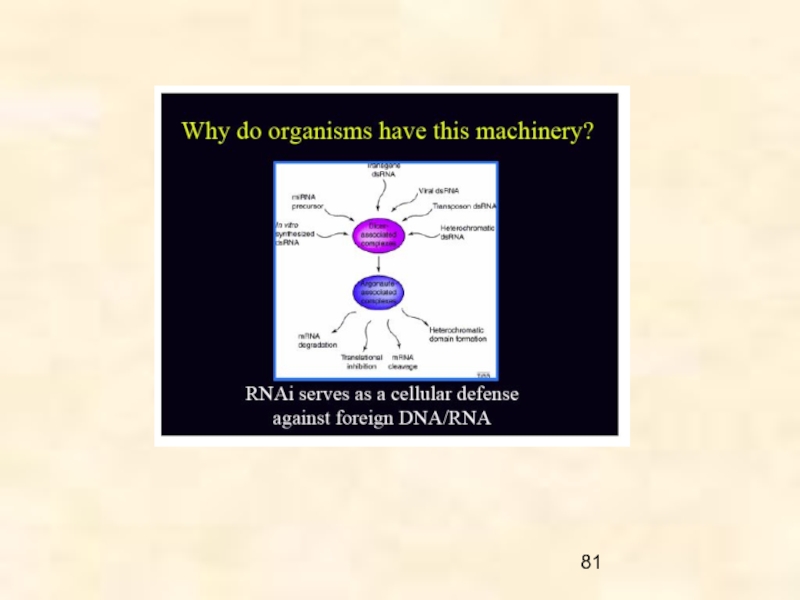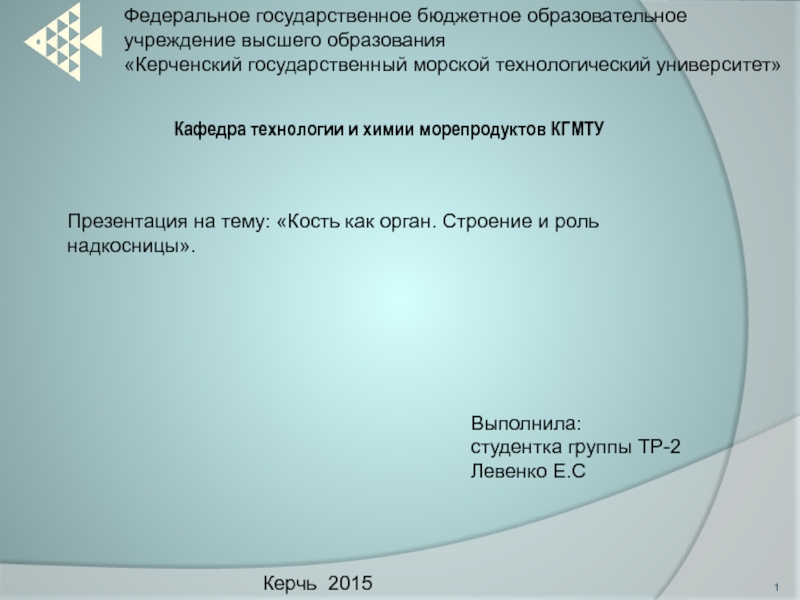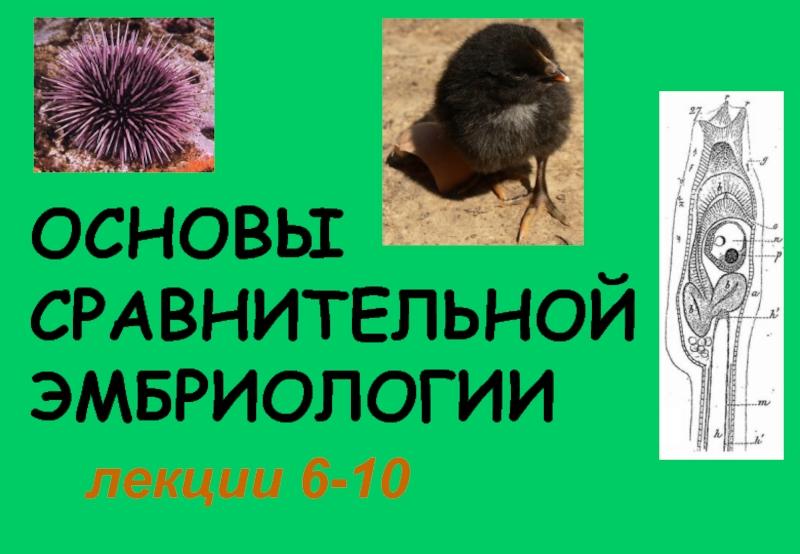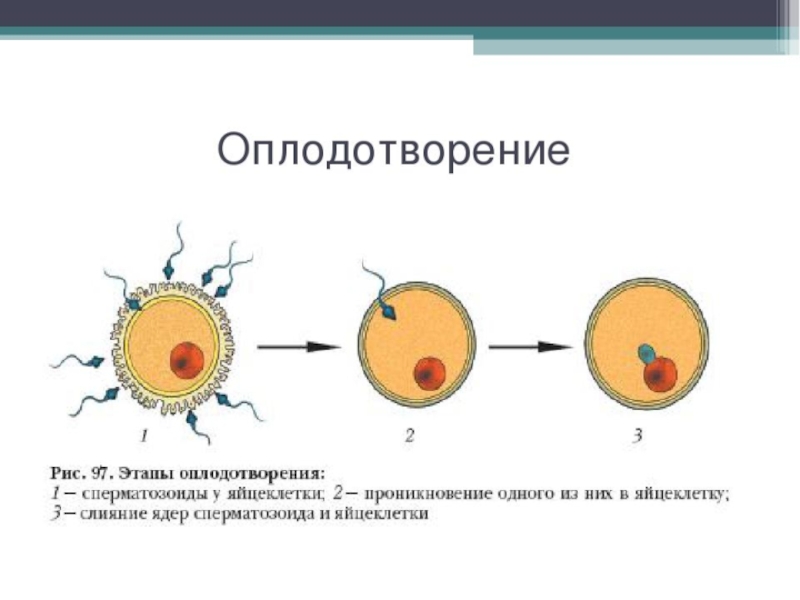- Главная
- Разное
- Дизайн
- Бизнес и предпринимательство
- Аналитика
- Образование
- Развлечения
- Красота и здоровье
- Финансы
- Государство
- Путешествия
- Спорт
- Недвижимость
- Армия
- Графика
- Культурология
- Еда и кулинария
- Лингвистика
- Английский язык
- Астрономия
- Алгебра
- Биология
- География
- Детские презентации
- Информатика
- История
- Литература
- Маркетинг
- Математика
- Медицина
- Менеджмент
- Музыка
- МХК
- Немецкий язык
- ОБЖ
- Обществознание
- Окружающий мир
- Педагогика
- Русский язык
- Технология
- Физика
- Философия
- Химия
- Шаблоны, картинки для презентаций
- Экология
- Экономика
- Юриспруденция
Short history of post-transcriptional gene silencing презентация
Содержание
- 1. Short history of post-transcriptional gene silencing
- 2. What is RNA interference /PTGS?
- 3. double-stranded RNAs are produced by: –
- 4. RNAi can be induced by:
- 8. Dicer Double-stranded RNA triggers processed into
- 10. RISC complex RISC is a large
- 11. Different classes of small RNA molecules During
- 12. siRNAs Small interfering RNAs that have
- 13. miRNAs/stRNAs micro/small temporal RNAs derive
- 14. MEM MEM )
- 15. Why is PTGS important? Most widely held
- 16. Recent applications of RNAi Modulation of
- 17. Possible future improvements of RNAi applications Already
- 18. Conclusions begun in worms, flies, and
- 19. Регуляция экспрессии генов с помощью miRNA
- 20. DNA-интерференция DNA-guided DNA interference by a
- 21. Функции siРНК Сайленсинг мобильных генетических элементов;
- 22. При выделение фракций коротких РНК
- 23. Функция miРНК Обеспечивают сайленсинг различных генов,
- 24. Продукт dsРНК, закодированных в уникальных генах
- 25. созданы библиотеки коротких РНК и ДНК-векторов,
- 26. Fig. 3. Structural preference of miRNA–miRNA*
- 27. In vivo gene-silencing effects of anti-
- 28. In vivo effects of anti-tyrosinase (
- 29. Morphological and genetic properties of mirPSCs.
- 30. Mechanism of miR-302–mediated tumor suppression in
- 32. What is RNA interference (RNAi)? “The Process
- 33. What are sense and antisense RNA? Messenger
- 34. What are sense and antisense RNA? Antisense
- 35. RNAi terms dsRNA: double stranded RNA, longer
- 36. RNAi like phenomena Plants Petunias
- 37. 1990-Petunias Napoli et al. defined an RNAi-like
- 38. Overexpression of chalcone synthase in petunias unexpectedly
- 39. 1992-The mold Carlo Cogoni and Guiseppe Macino
- 40. 1995-The worm Guo and Kemphues studied par-1
- 41. 1995- The worm Guo and Kemphues first
- 42. Guo and Kemphues, 1995
- 43. Both the antisense and sense strands effectively silenced wildtype Par-1 RNAi
- 44. ‘Antisense’ Technology? Sense RNA silences yet no
- 45. Craig Mello In 1996, C. Mello and
- 46. 1998-Fire et al and Mello Gel-purified ssRNA
- 47. Unc-22 (Uncoordinated 22) Codes for a non
- 48. Injection for RNAi 6-10 adult hermaphrodites were injected with 0.5x106-1x106 molecules into each gonadal arm.
- 49. Unc-22 phenotype 4-6 hours after injection, eggs collected. Screened for phenotypic changes twiching
- 50. Mex-3 mex-3 encodes two RNA binding proteins;
- 51. Mex-3 RNAi b, Embryo from uninjected
- 52. RNAi concentration and dose response 3.6x106 molecules/gonad
- 53. Quantitative Assays
- 54. Other possibilities Sense+antisense in low salt Rapid
- 55. Conclusions www.nobelprize.org
- 56. Conclusions www.nobelprize.org
- 57. Ways to induce silent phenotypes Timmons and
- 58. Ways to induce silent phenotypes Tabarra, Grishok,
- 59. Mechanisms revealed 25bp species of dsRNA found
- 60. RNAi: two phases Initiation Generation of mature
- 61. How does RNAi work? www.nobelprize.org
- 62. siRNA biogenesis Dicer (type III RNAse III)
- 63. RNA Induced Silencing Complex (RISC) RNAi effector
- 64. siRNA design Mittal, 2004
- 65. Custom-made siRNAs
- 66. siRNA libraries Generation of a feeding clone
- 67. Endogenous RNAi-miRNA We have hundreds of different
- 68. Defense Against Viruses www.nobelprize.org Indeed, Baulcombe, Vance,
- 69. Mammalian RNAi McManus and Sharp, 2002
- 70. Getting Around the Problem siRNA (21-22nt) mediate
- 71. Some applications of RNAi Therapy Candidate genes,
- 72. Genome-wide RNAi Only 11% genes showed detectable
- 73. Systems Biology and RNAi Cellular systems act
- 74. Networks of Early Embryogenesis Protein-protein interaction dataset:
- 75. Systems Biology Approach: Three networks in one
- 76. The embryogenesis network
- 77. Discovery Project
- 78. Defense against transposons RNAi may also help
- 80. Why use RNAi? 1. The most powerful
Слайд 1Short history of post-transcriptional gene silencing
Definition: the ability of exogenous
1990 Jorgensen :
Introduction of transgenes homologous to endogenous genes often resulted in plants with both genes suppressed!
Called Co-suppression
Resulted in degradation of the endogenous and the
transgene mRNA
1995 Guo and Kemphues:
injection of either antisense or sense RNAs in the germline of C. elegans was equally effective at silencing homologous target genes
1998 Mello and Fire:
-extension of above experiments, combination of sense and antisense RNA (= dsRNA) was 10 times more effective than single strand RNA
Слайд 2What is RNA interference /PTGS?
dsRNA needs to be directed
intron in order to be effective
homology of the dsRNA and the target gene/mRNA is
required
targeted mRNA is lost (degraded) after RNAi
the effect is non-stoichiometric; small amounts of
dsRNA can wipe out an excess of mRNA (pointing to
an enzymatic mechanism)
ssRNA does not work as well as dsRNA
Слайд 3 double-stranded RNAs are produced by:
– transcription of inverted repeats
– viral
– transcription of RNA by RNA-dependent RNA-
polymerases (RdRP)
double-stranded RNA triggers cleavage of
homologous mRNA
PTGS-defective plants are more sensitive to infection
by RNA viruses
in RNAi defective nematodes, transposons are much
more active
Слайд 8Dicer
Double-stranded RNA triggers processed into siRNAs by enzyme RNAseIII family,
Dicer family proteins are ATP-dependent nucleases.
These proteins contain an amino-terminal helicase domain, dual RNAseIII domains in the carboxy- terminal segment, and dsRNA-binding motifs.
They can also contain a PAZ domain, which is thought to be important for protein-protein interaction.
Dicer homologs exist in many organisms including C. elegans, Drosphila, yeast and humans
Loss of dicer: loss of silencing, processing in vitro
Developmental consequence in Drosophila and C. elegan
Слайд 10RISC complex
RISC is a large (~500-kDa) RNA-multiprotein complex, which
some components have been defined by genetics, but function
is unknown, e.g.
– unwinding of double-stranded siRNA (Helicase !?)
– ribonuclease component cleaves mRNA (Nuclease !?)
– amplification of silencing signal (RNA-dependent RNA polymerase !?)
cleaved mRNA is degraded by cellular exonucleases
Слайд 11Different classes of small RNA molecules
During dsRNA cleavage, different RNA classes
– siRNA
– miRNA
– stRNA
Слайд 12siRNAs
Small interfering RNAs that have an integral role in
a form of post-transcriptional gene silencing
RNAi: 21-25 nt fragments, which bind to the
complementary portion of the target mRNA
and tag it for degradation
A single base pair difference between the siRNA
template and the target mRNA is enough to block
the process.
Слайд 13miRNAs/stRNAs
micro/small temporal RNAs derive from ~70 nt ssRNA (single-stranded
which forms a stemloop; processed to 22nt RNAs found in:
– Drosophila, C. elegans, HeLa cells genes
– Lin-4, Let-7
stRNAs do not trigger mRNA degradation role: the temporal regulation of C. elegans development, preventing translation of their target mRNAs by binding to the target’s complementary 3’
untranslated regions(UTRs)
conservation: 15% of these miRNAs were conserved with 1-2 mismatches across worm, fly, and mammalian genomes
expression pattern: varies; some are expressed in all cells and at all developmental stages and others have a more restricted spatial and temporal expression pattern
Слайд 15Why is PTGS important?
Most widely held view is that RNAi evolved
Recently, very small (micro) RNAs have been
discovered in several eukaryotes that regulate
developmentally other large RNAs
May be a new use for the RNAi mechanism besides defense
Слайд 16Recent applications of RNAi
Modulation of HIV-1 replication by RNA interference.
Hannon(2002).
virus type 1 replication by RNA interference.
An et al.(1999)
Selective silencing of viral gene expression in HPV-positive
human cervical carcinoma cells treated with siRNA, a primer
of RNA interference.
Jung et al. 2002.
RNA interference in adult mice.
Mccaffrey et al.2002
Successful inactivation of endogenous Oct-3/4 and c-mos
genes in mouse pre implantation embryos and oocytes using
short interfering RNAs.
Le Bon et al.2002
Слайд 17Possible future improvements of RNAi applications
Already developed:
in vitro synthesis of siRNAs
U6 RNA promoter based plasmids
Digestion of longer dsRNA by E. coli Rnase III
Potentially useful:
creation of siRNA vectors with resistances cassettes
establishment of an inducible siRNA system
establishment of retroviral siRNA vectors (higher efficiencies,
infection of suspension cell lines)
Слайд 18Conclusions
begun in worms, flies, and plants - as an accidental
general applications in mammalian cells.
probably much more common than appreciated before:
– it was recently discovered that small RNAs correspond to centromer heterochromatin repeats
– RNAi regulates heterochromatic silencing
Faster identification of gene function
Powerful for analyzing unknown genes in sequence genomes.
efforts are being undertaken to target every
human gene via miRNAs
Gene therapy: down-regulation of certain genes/mutated alleles
Cancer treatments
– knock-out of genes required for cell proliferation
– knock-out of genes encoding key structural
proteins
Agriculture
Слайд 20
DNA-интерференция DNA-guided DNA interference by a prokaryotic Argonaute. Swarts DC, Jore
•Механизм РНК-интерференции осуществляется за счет очень консервативного семейства белков Argonaute (Ago)
•Белки семейства Argonaute есть даже у прокариот, но механизма RNA-интерференции нет.
•Оказалось, что у одной эубуктерии Thermus thermophilus белок TtAgo реализует механизм DNA-интерференции, аналогичным образом.
•Затравкой для него являются 5’-фосфорилированные ДНК олигонуклеотиды длинной 13-25 нуклеотидов.
•Считается, что бактерия тем самым защищается от чужеродной ДНК.
Защита от ДНК Защита от РНК Регуляция экспрессии
Слайд 21Функции siРНК
Сайленсинг мобильных генетических элементов;
Сайленсинг гетерохроматиновых повторов;
Сайленсинг генетического материала вирусного
Ограничение степени экспрессии гена в определенных тканях.
Слайд 22При выделение фракций коротких РНК (19-25 нуклеотидов) из
МикроРНК (miRNAs - micro RNAs) – класс 19-25 нуклеотидных одноцепочечных РНК, закодированных в уникальных генах геномов многоклеточных организмов.
Слайд 23Функция miРНК
Обеспечивают сайленсинг различных генов, обычно, за счет частично комплементарного связывания
один тип miРНК может регулировать трансляцию мРНК более 100 различных генов;
степень ингибирования зависит от количества связывающихся miРНК (в 3’UTR мРНК содержится несколько сайтов связывания).
Слайд 24
Продукт dsРНК, закодированных в уникальных генах геномов многоклеточных организмов (>1% от
мРНК может не разрушаться;
Один тип miРНК регулирует разные гены.
Продукт dsРНК, образующихся в результате транскрипции транспозонов, гетерохроматиновых повторов или генетического материала вирусного происхождения ;
мРНК разрушается;
Один тип siРНК обычно регулирует только один тип мРНК.
miРНК
siРНК
Отличия miРНК и siРНК
Слайд 25 созданы библиотеки коротких РНК и ДНК-векторов, кодирующих короткие РНК, мишенями
внедряется в практику терапевтическое применение синтетических коротких РНК для целенаправленного подавления генетической экспрессии при некоторых заболеваниях.
Слайд 26
Fig. 3. Structural preference of miRNA–miRNA* asymmetry in miRNA-induced gene silencing
Different preferences of RISC assembly were observed by transfection of 5 ў -miRNA*-stem-loop-miRNA-3 ў (❶) and
5 ў -miRNA-stem-loop-miRNA*-3 ў (❷) pri-miRNA constructs in zebra fi sh, respectively. ( a ) Based on the RISC assembly ruleof siRNA, the processing of both ❶ and ❷ should result in the same siRNA duplex for RISC assembly; however, the experiments
demonstrate that only the ❷ construct was used in RISC assembly for silencing target EGFR. Due to the fact that
miRNA is predicted to be complementary to its target messenger RNA, the “antisense” ( black bar ) refers to the miRNA and
the “sense” ( white bar ) refers to its complementarity, miRNA*. One mature miRNA, namely miR-eGFP-(280/302), was
detected in the ❷-transfected zebra fi shes, whereas the ❶ transfection produced different miRNA: miR*-EGFR(301–281),
which was partially complementary to the miR-eGFP(280/320). ( b ) In vivo gene silencing ef fi cacy was only observed in the
transfection of the ❷ pri-miRNA construct, but not the ❶ construct. Because the color combination of EGFP and RGFP
displayed more red than green (as shown in deep orange ), the expression level of target EGFP ( green ) was signi fi cantly
reduced in ❷, while miRNA indicator RGFP ( red ) was evenly present in all vector transfections. ( c ) Western blot analysis of
the EGFP protein levels con fi rmed the speci fi c silencing result of ( b ). No detectable gene silencing was observed in fi shes
without (Ctl) and with liposome only (Lipo) treatments. The transfection of either a U6-driven siRNA vector (siR) or an empty
vector (Vctr) without the designed pri-miRNA insert resulted in no gene silencing signi fi cance.
Слайд 27
In vivo gene-silencing effects of anti- b -catenin miRNA and anti-noggin
( a ) The pre-miRNA-expressing construct and fast green dye mixtures were injected into the chickenembryos near the liver primordia below the heart. ( b ) Northern blots of extracted RNAs from chicken embryonic livers with( lanes 1–3 ) and without ( lanes 4–6 ) anti- b -catenin miRNA treatments were shown. All three knockouts (KO) showed a greater than 98% silencing effect on b -catenin mRNA expression but housekeeping genes, such as glyceraldehyde phosphate dehydrogenase , was not affected. ( c ) Liver formation of the b -catenin KOs was signi fi cantly hindered ( upper right two panels ). Microscopic examination revealed a loose structure of hepatocytes, indicating the loss of cell–cell adhesion caused by breaks in adherins junctions formed between b -catenin and cell membrane E-cadherin in early liver development. In severely affected regions, feather growth in the skin close to the injection area was also inhibited ( lower right two panels ). Immunohistochemistry for b -catenin protein expression ( brown ) showed a signi fi cant decrease in the feather follicle sheaths. H&E Hematoxyline and eosin staining. ( d ) The lower beak development was increased by the mandible injection of the anti-noggin pre-miRNA construct ( down panel ) in comparison with the wild type ( upper panel ). Right panels showed bone (alizarin red) and cartilage (alcian blue) staining to demonstrate the outgrowth of bone tissues in the lowerbeak of the noggin KO. Northern blot analysis (inserts) con fi rmed a 60–65% decrease of noggin mRNA expression in thelower beak area.
Слайд 28
In vivo effects of anti-tyrosinase ( Tyr ) miRNA on the
Слайд 29
Morphological and genetic properties of mirPSCs. ( a ) A morphological
embryo and an mirPSC colony at 16–32-cell stage. BF-DIC bright field with differential interference contrast.
( b ) Fluorescent microscope examination showing the homogeneous expression of the core reprogramming factors
Oct3/4, Sox2 and Nanog in an mirPSC-derived embryoid body. ( c ) Western blots con fi rming the expression
patterns of major human embryonic stem cell (hESC)-speci fi c markers in mirPSCs compared to those found in
hESCs H1 and H9 ( n = 4, p < 0.01).
Слайд 30
Mechanism of miR-302–mediated tumor suppression in human iPSCs. miR-302 not only
G1-phase checkpoint regulators cyclin-dependent kinase 2 (CDK2), cyclin D and BMI-1 but also indirectly activates
p16Ink4a and p14/p19Arf to quench most (>70%) of the cell cycle activities during somatic cell reprogramming (SCR). E2F
is also a predicted target of miR-302. Relative quiescence at the G0/G1 state may prevent possible random growth and/or
tumor-like transformation of the reprogrammed iPSCs, leading to a more accurate and safer reprogramming process, by
which premature cell differentiation and tumorigenicity are both inhibited
Слайд 32What is RNA interference (RNAi)?
“The Process by which dsRNA silences gene
Degradation of mRNA or translation inhibition
www.nobelprize.org
Слайд 33What are sense and antisense RNA?
Messenger RNA (mRNA) is single-stranded, called
5´ C U U C A 3´ mRNA
3´ G A A G U 5´ Antisense RNA
Слайд 34What are sense and antisense RNA?
Antisense molecules interact with complementary strands
5´ C U U C A 3´ mRNA
3´ G A A G U 5´ Antisense RNA
Слайд 35RNAi terms
dsRNA: double stranded RNA, longer than 30 nt
miRNA: microRNA, 21-25
Encoded by endogenous genes
siRNA: small-interfering RNA, 21-25 nt.
Mostly exogenous origin
Слайд 36
RNAi like phenomena
Plants
Petunias
Fungi
Neurospora
Animals
Caenorhabditis elegans
Alternate terms to RNAi
PTGS (Posttranscriptional Gene Silencing)
Cosuppression
Quelling
Virus-induced
Слайд 371990-Petunias
Napoli et al. defined an RNAi-like phenomenon and called it “cosupression.”
chalcone
Слайд 38Overexpression of chalcone synthase in petunias unexpectedly resulted in white petunias
The
http://www.scq.ubc.ca/?p=265
Слайд 391992-The mold
Carlo Cogoni and Guiseppe Macino of the Università di Roma
The introduced gene led to inactivation of the mold's own gene in about 30% of the transformed cells. They called this gene inactivation "quelling."
A rosette of the asci
Слайд 401995-The worm
Guo and Kemphues studied par-1 gene during embryogenesis
The worm, C.
has a fixed lineage: hypodermis, intestine, gonads
asymmetric divisions
Слайд 411995- The worm
Guo and Kemphues first studied Par-1 gene mutants
Division: Asymmetric?symmetric
P-granule
Слайд 44‘Antisense’ Technology?
Sense RNA silences yet no hybridization of sense RNA with
Intronic and promoter sequences do not silence.
ssDNA or dsDNA does not work!
Craig Mello at the Worm Meeting in Madison, Wisconsin coined the term ‘RNAi’ and said that:
“ We can’t call it ‘antisense’ when ‘sense’ works as well”*
*Montgomery (2006) RNA interference: unraveling a mystery
Слайд 45Craig Mello
In 1996, C. Mello and his student S. Driver also
Injection is made into a single site yet acts more systemically.
Andrew Fire
In 1991, A. Fire successfully targeted genes by antisense constructs from transgenes.
Sense constructs also exhibited silencing activity.
Слайд 461998-Fire et al and Mello
Gel-purified ssRNA
Used purified ssRNA (antisense and
Tested ssRNA against different genes for specificity
Tested whether a general post-transcriptional silencing is in place.
Слайд 47Unc-22 (Uncoordinated 22)
Codes for a non essential myofilament
It is present several
Слайд 48Injection for RNAi
6-10 adult hermaphrodites were injected with 0.5x106-1x106 molecules into
Слайд 49Unc-22 phenotype
4-6 hours after injection, eggs collected.
Screened for phenotypic changes
twiching
Слайд 50Mex-3
mex-3 encodes two RNA binding proteins; in the early embryo, maternally
Mex-3 is required for specifying the identities of the anterior AB blastomere and its descendants, as well as for the identity of the P3 blastomere and proper segregation of the germline P granules
Слайд 51Mex-3 RNAi
b, Embryo from uninjected parent (showing normal pattern of endogenous
c, Embryo from a parent injected with purified mex-3B antisense RNA. Retain the mex-3 mRNA, although levels may be somewhat less than wild type.
d, Embryo from a parent injected with dsRNA corresponding to mex-3B; no mex-3 RNA is detected.
Слайд 52RNAi concentration and dose response
3.6x106 molecules/gonad
Sense phenocopied 1% of progeny
Antisense phenocopied
dsRNA phenocopies 100% progeny and at even 3x108 molecules/gonad.
Слайд 54Other possibilities
Sense+antisense in low salt
Rapid sequential injection of sense & antisense
Both
1 hour apart injection of sense and antisense leads to reduction in interference.
Слайд 57Ways to induce silent phenotypes
Timmons and Fire showed that feeding dsRNA
Reversible and gene-specific effects…
Слайд 58Ways to induce silent phenotypes
Tabarra, Grishok, and Mello in 1998 demonstrated
Nomarski image showing embryos produced by a wild-type mother treated with pos-1 RNAi by soaking. All except one embryo (arrow) show the distinctive pos-1 embryonic arrest with no gut, no body morphogenesis, and extra hypodermal cells
pos-1 encodes a CCCH-type zinc-finger protein; maternally provided POS-1 is essential for proper fate specification;
Слайд 59Mechanisms revealed
25bp species of dsRNA found in plants with co-suppression [Hamilton
Sequence similar to gene being suppressed
Drosophila: long dsRNA “triggers” processed into 21-25bp fragments [Elbashir et al., 2001]
Fragments = short interfering RNA (siRNA)
siRNA necessary for degradation of target
Слайд 60RNAi: two phases
Initiation
Generation of mature siRNA or miRNA
Execution
Silencing of target gene
Degradation
Слайд 62siRNA biogenesis
Dicer (type III RNAse III) cleaves long dsRNA into siRNA
Symmetric 2nt 3’ overhangs, 5’ phosphate groups
Evidence for amplification in C. elegans and plants
Слайд 63RNA Induced Silencing Complex (RISC)
RNAi effector complex
Preferentially incorporates one strand of
Antisense
How does it know which is which?
The strand with less 5’ stability usually incorporated into RISC [Schwarz et al., 2003]
Слайд 66siRNA libraries
Generation of a feeding clone
Tuschl, 2003
siRNA libraries
Result: 16 757 bacterial
86.3% of predicted genes with RNAi phenotypes assigned
Слайд 67Endogenous RNAi-miRNA
We have hundreds of different genes that encode small RNA
First miRNA is lin-4
www.nobelprize.org
Слайд 68Defense Against Viruses
www.nobelprize.org
Indeed, Baulcombe, Vance, and others have shown that, in
Слайд 70Getting Around the Problem
siRNA (21-22nt) mediate mammalian RNAi
Introducing siRNA instead of
Слайд 71Some applications of RNAi
Therapy
Candidate genes, drug discovery, and therapy
Genome-wide RNAi screens
Gene
Candidate genes and drug discovery
Systems biology
Models of molecular machines
Слайд 72Genome-wide RNAi
Only 11% genes showed detectable RNAi phenotype
Between 600-800 genes are
Слайд 73Systems Biology and RNAi
Cellular systems act as networks of interacting components
Genome-wide RNAi screens offers the potential for revealing functions of each protein.
Combining RNAi screen data with other highthroughput data (e.g., protein-protein interaction, mRNA expression profiling) leads to understanding of the organization of the cell system.
Слайд 74Networks of Early Embryogenesis
Protein-protein interaction dataset: binary physical interactions between 3,848
Transcriptome dataset: expression profiling similarity above a given threshold among genes in the network
Phenotypic dataset: phenotypic similarity above another threshold of 661 early embryogenesis genes. RNA interference (RNAi) phenotypic signature consisting of a vector describing specific cellular defects in early embryogenesis.
Слайд 78Defense against transposons
RNAi may also help keep the transposable elements that
Слайд 80Why use RNAi?
1. The most powerful way to inhibit gene expression
2. Works in any cell/organism
3. Uses conserved endogenous machinery
4. Potent at low concentrations
5. Highly specific.
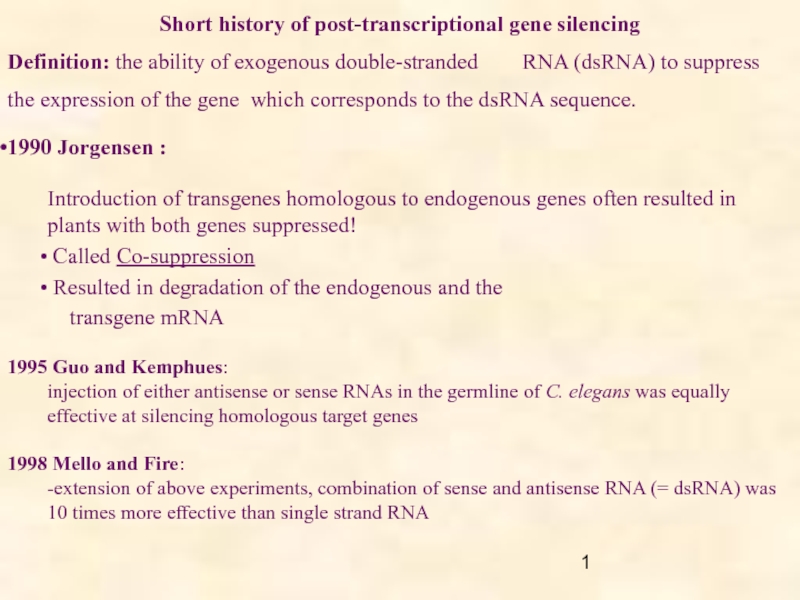
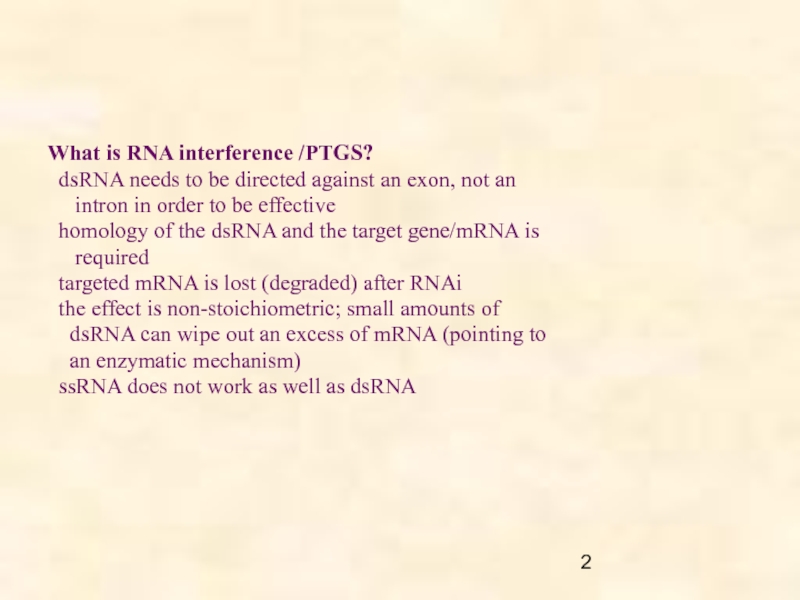
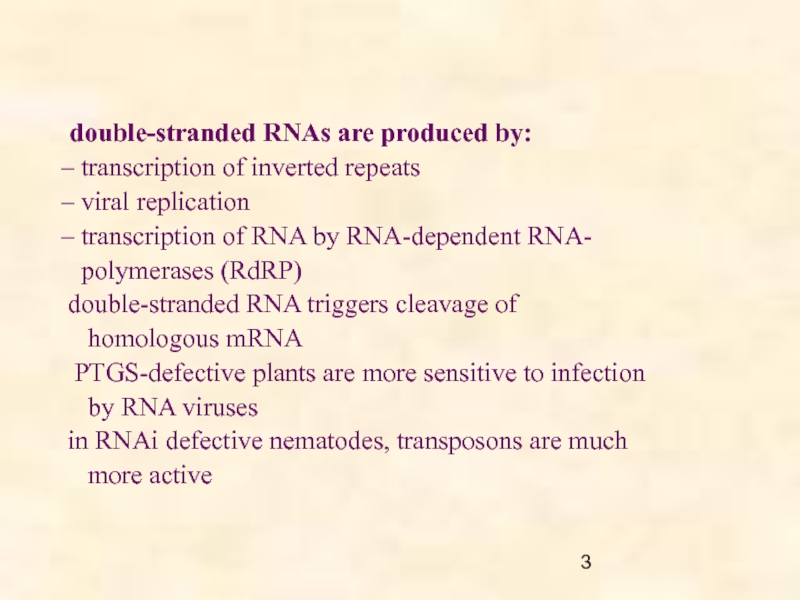
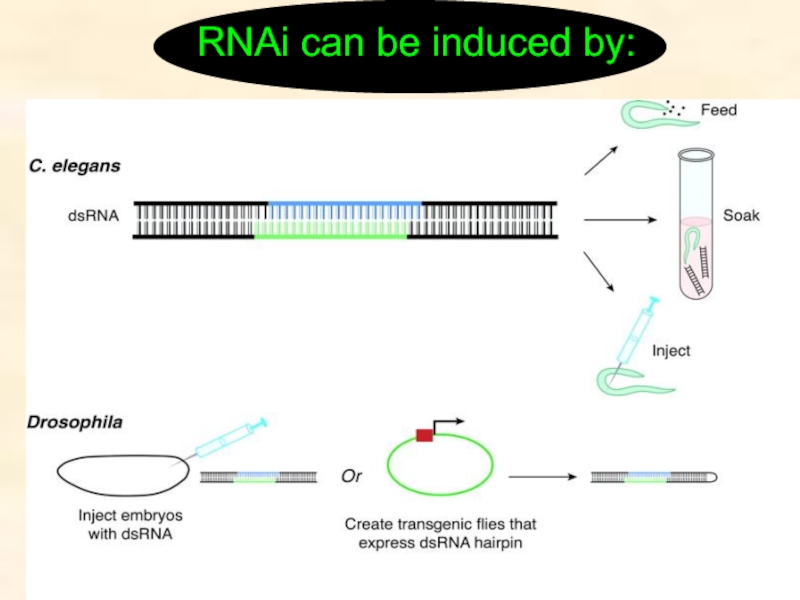
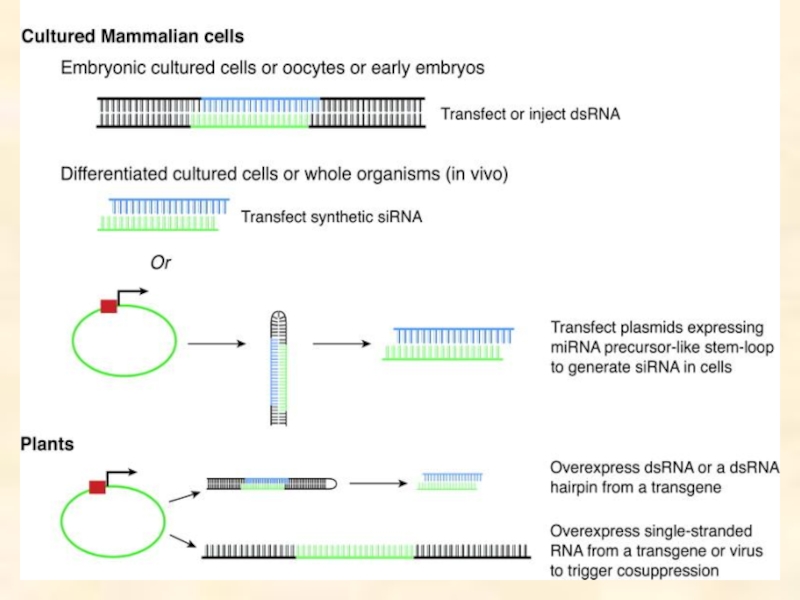
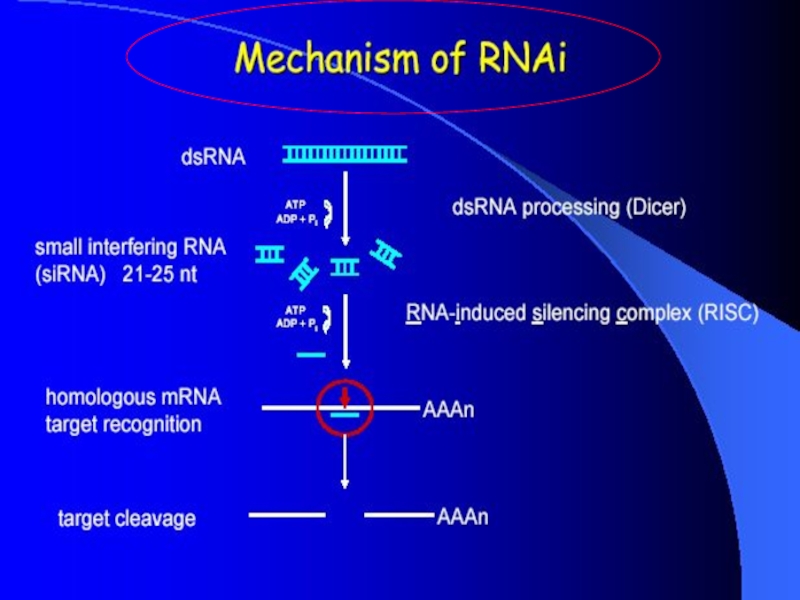

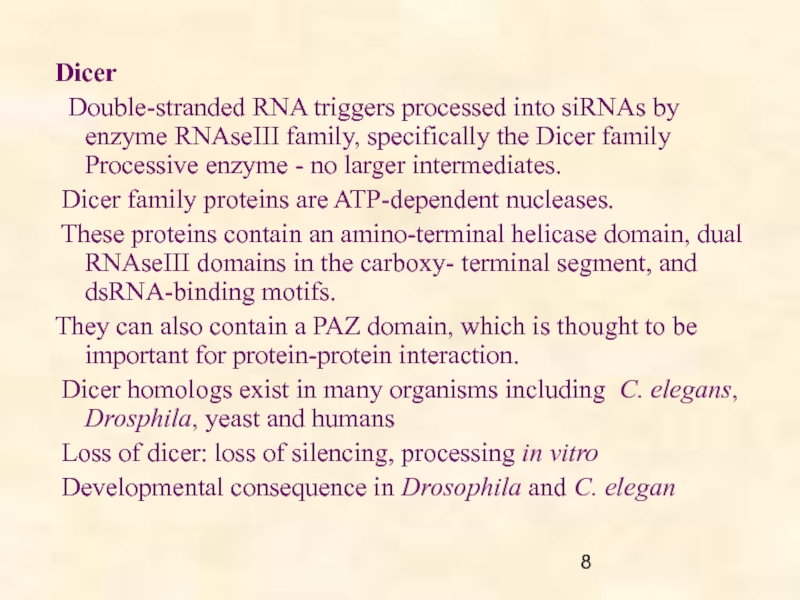
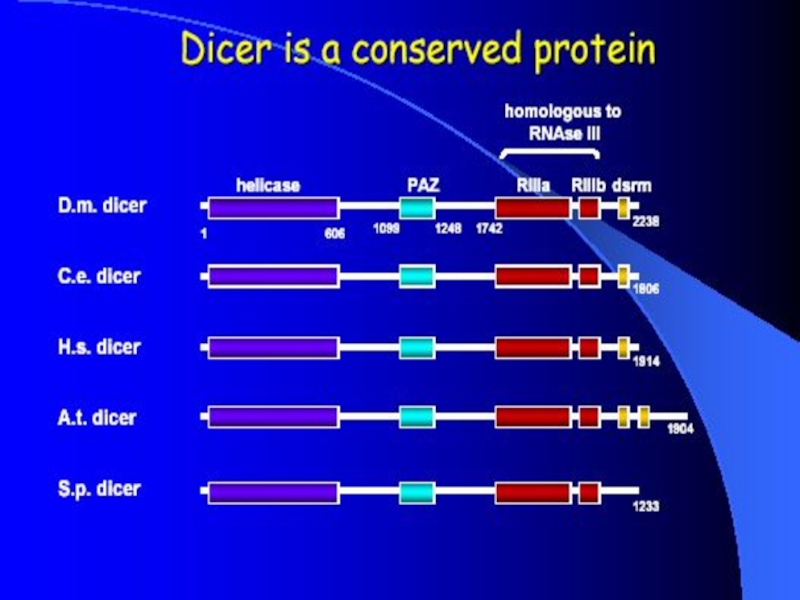
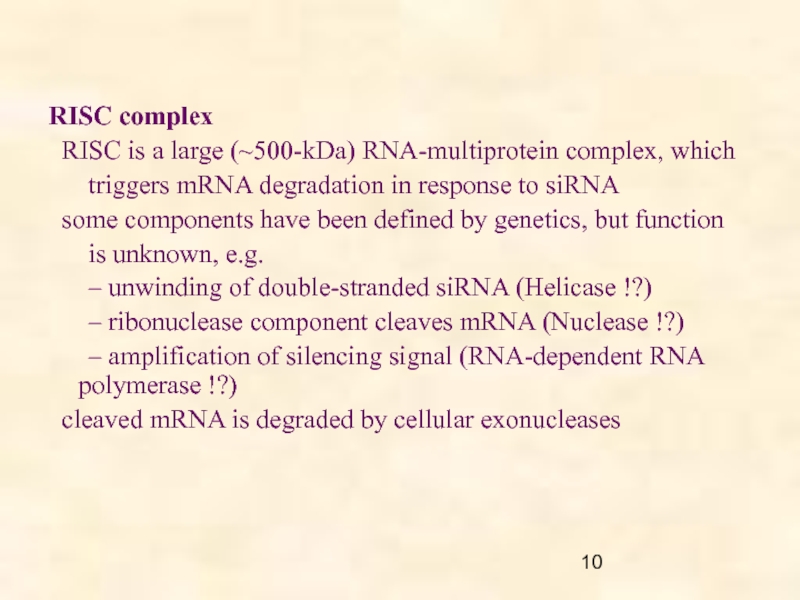
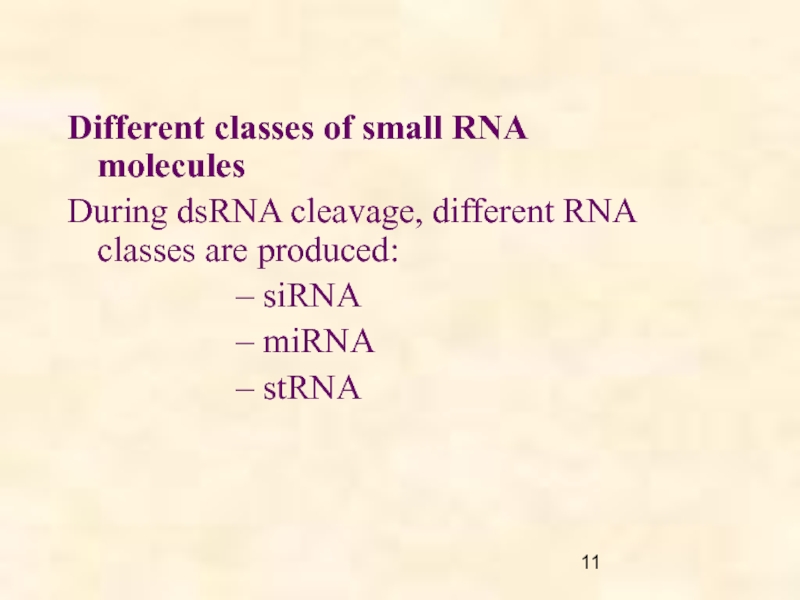
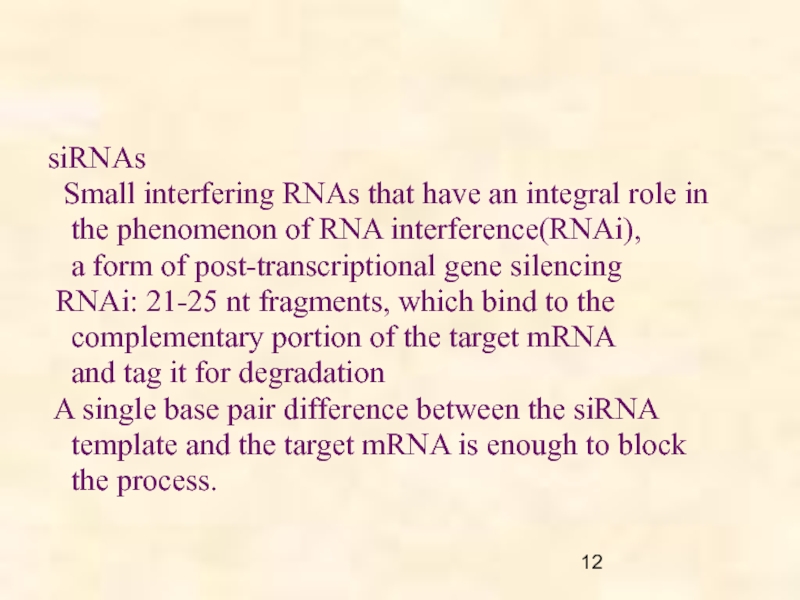
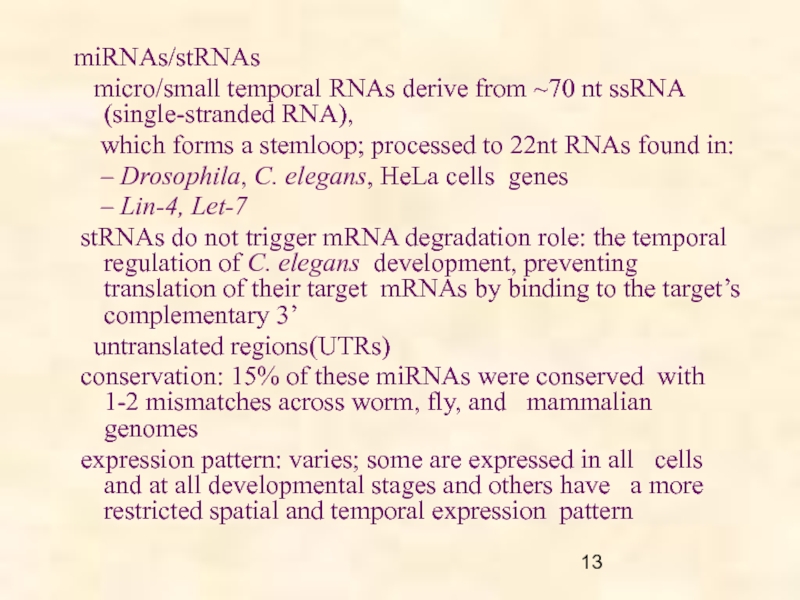
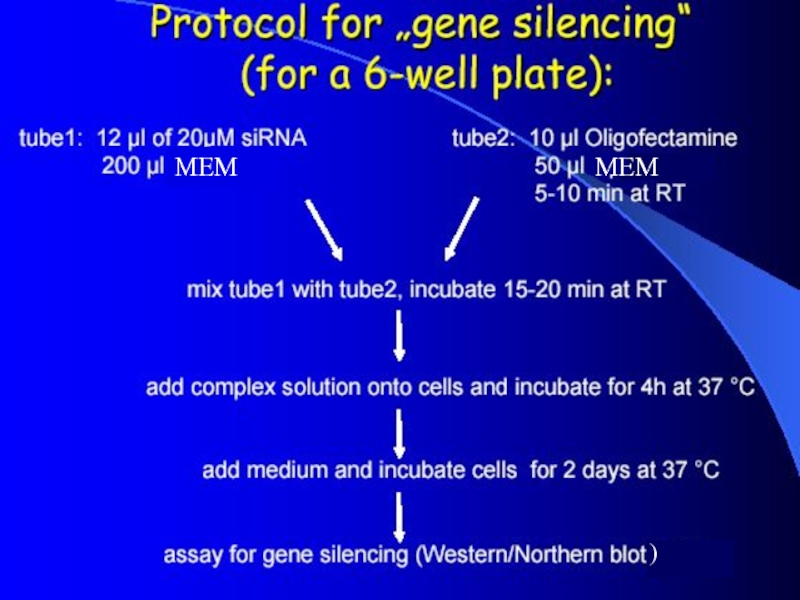
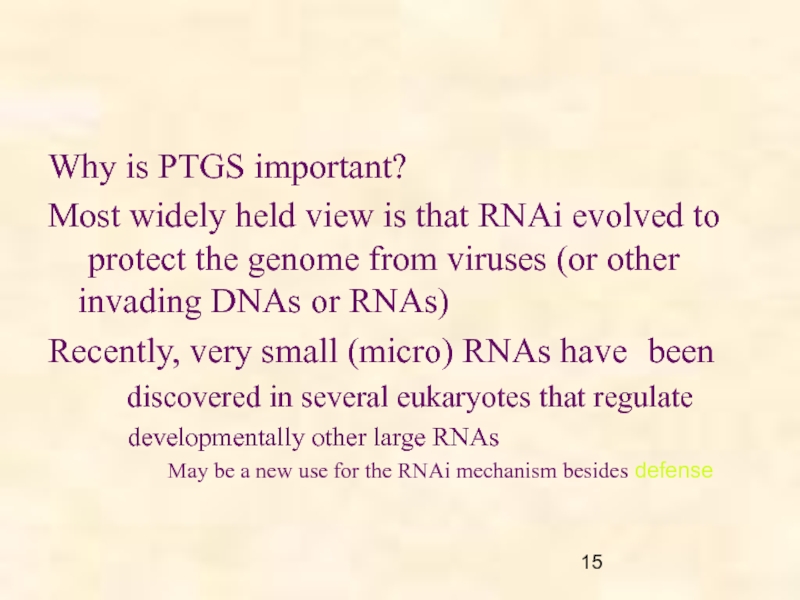
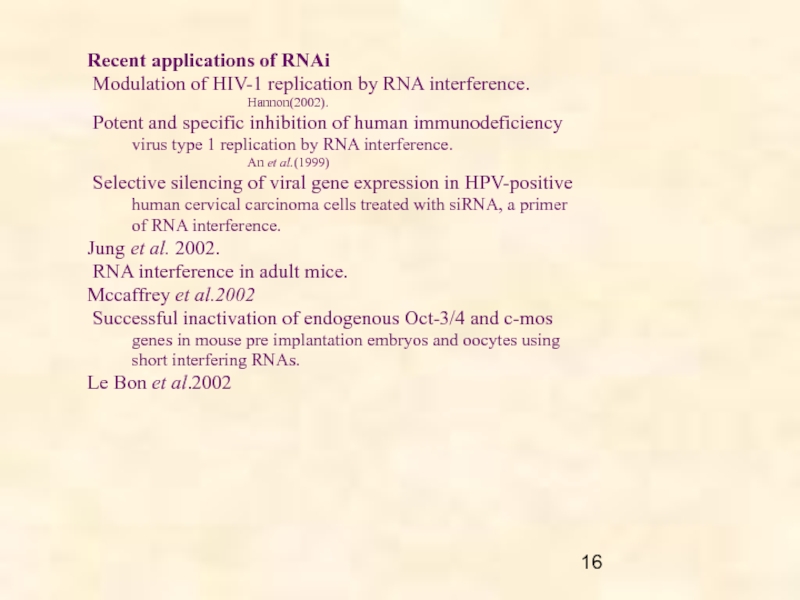
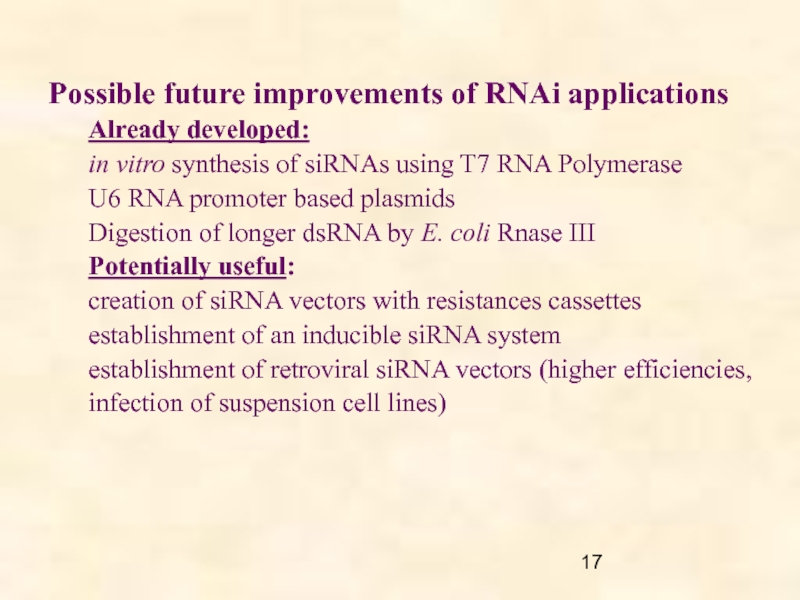
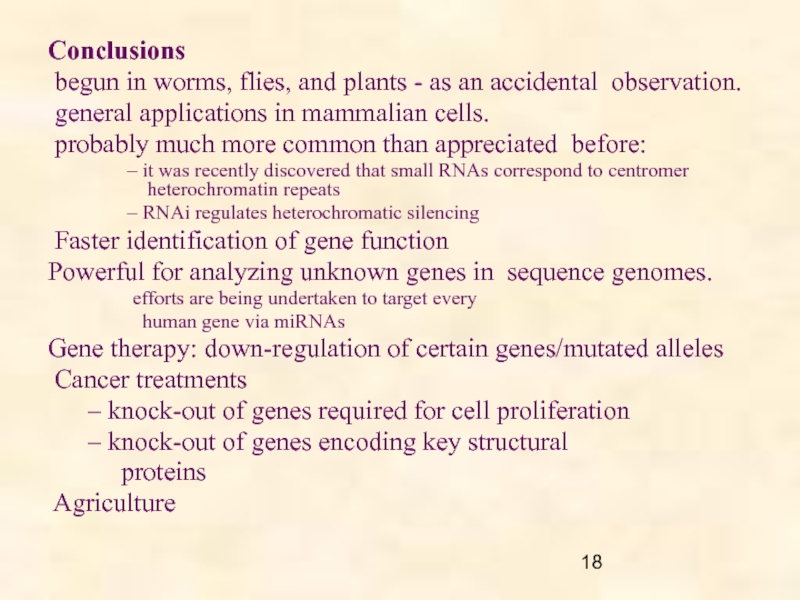
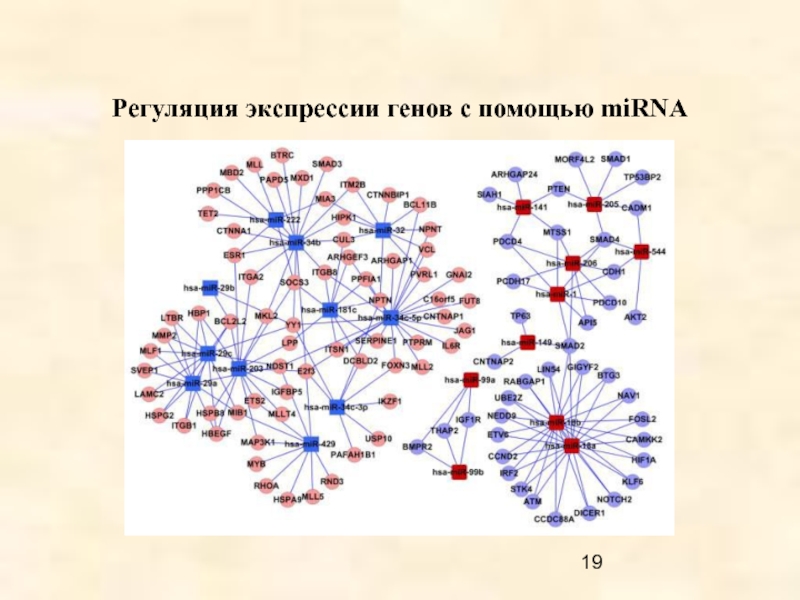
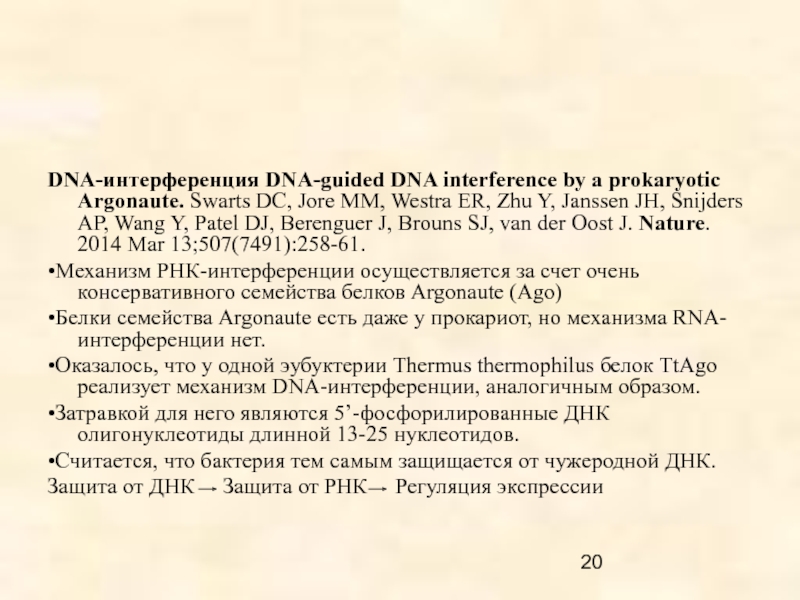

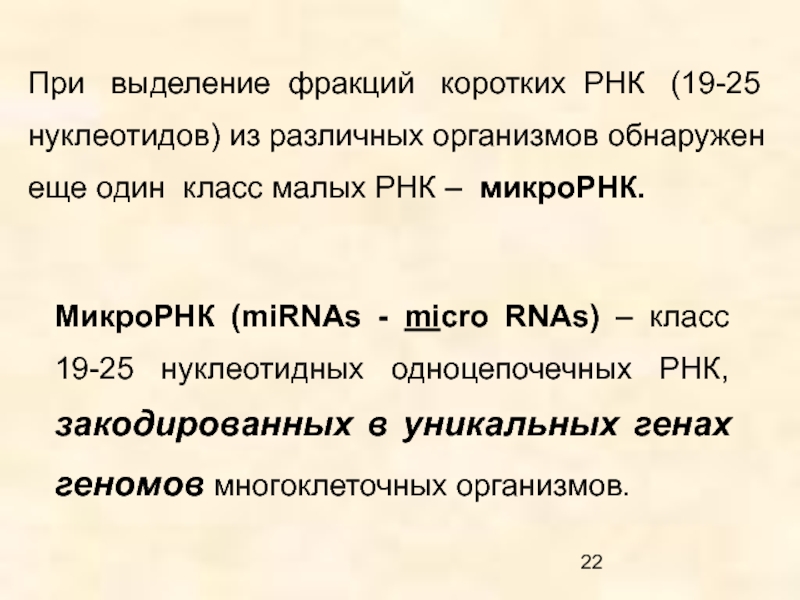
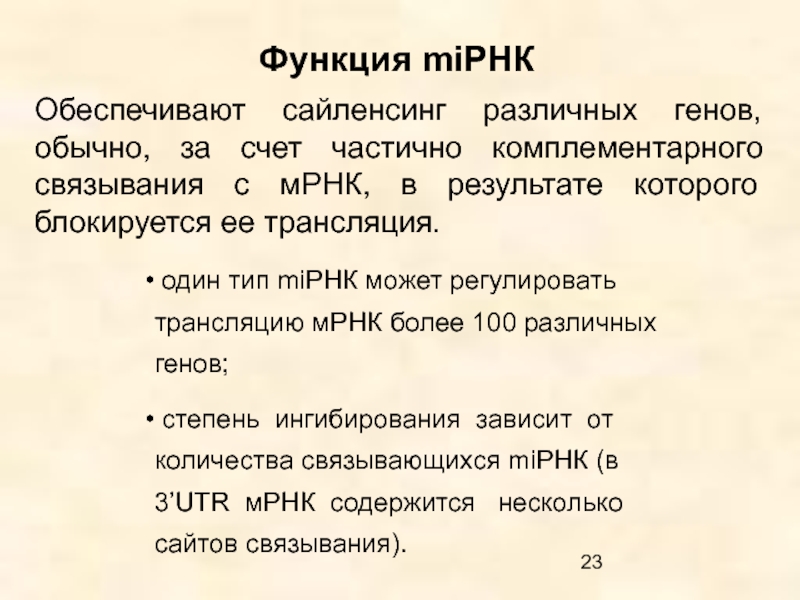
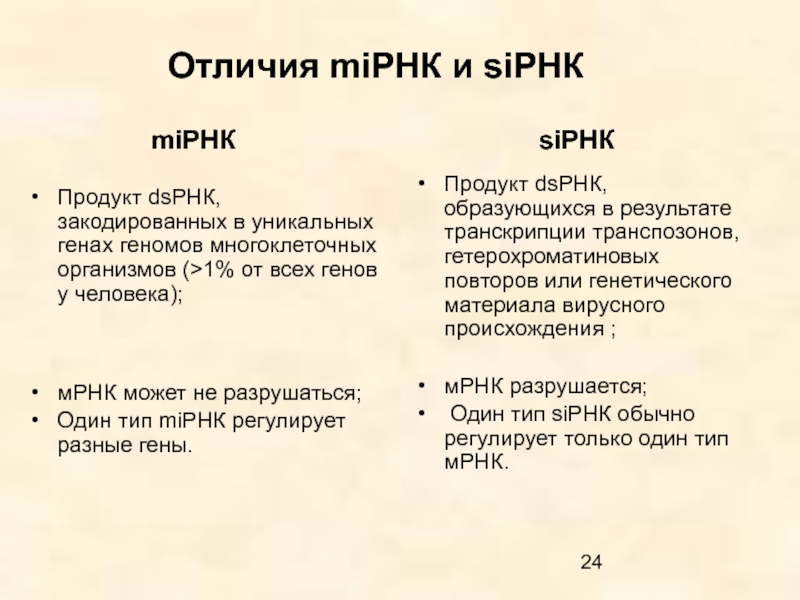

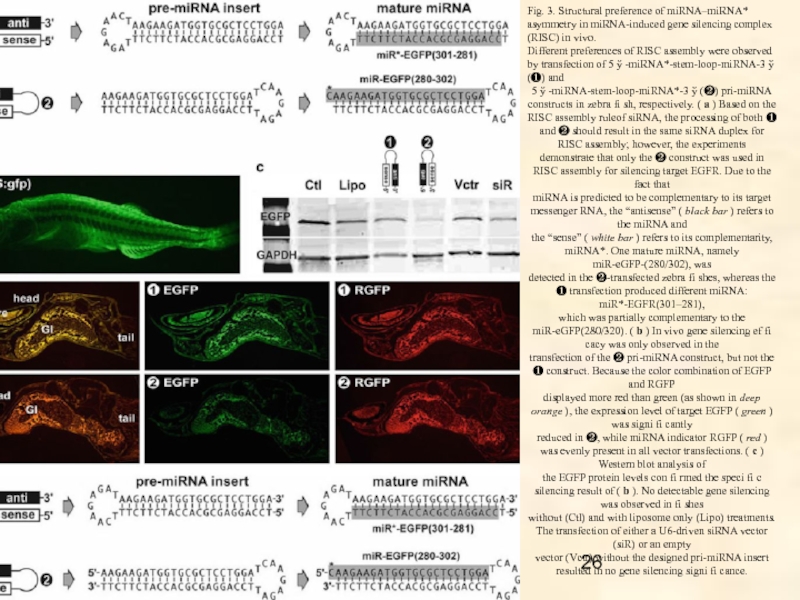
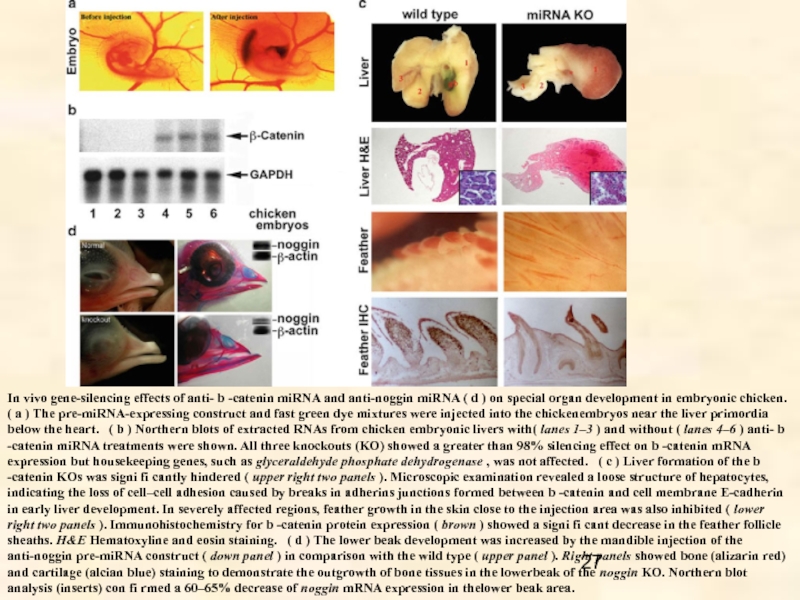
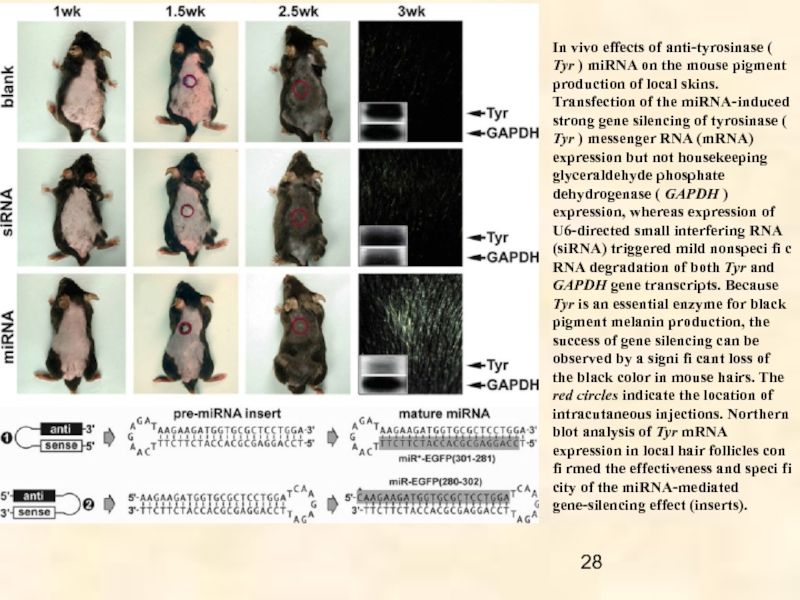
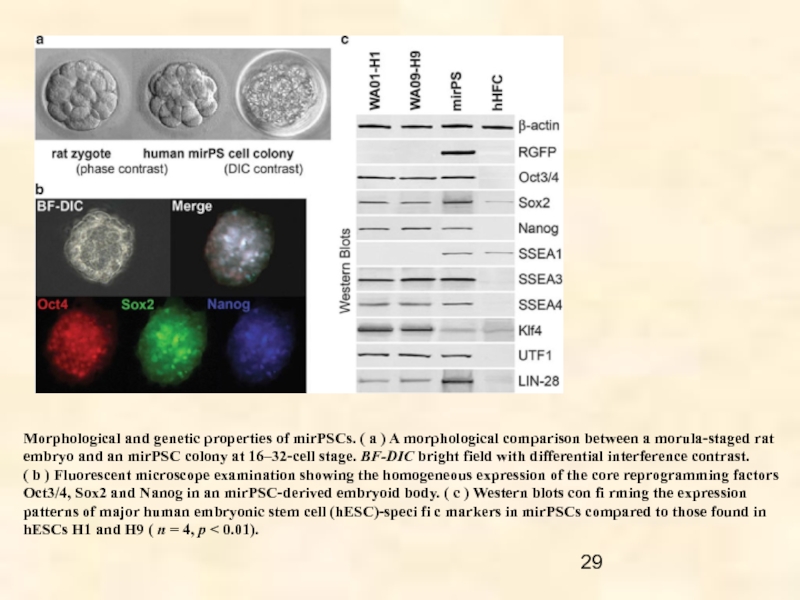
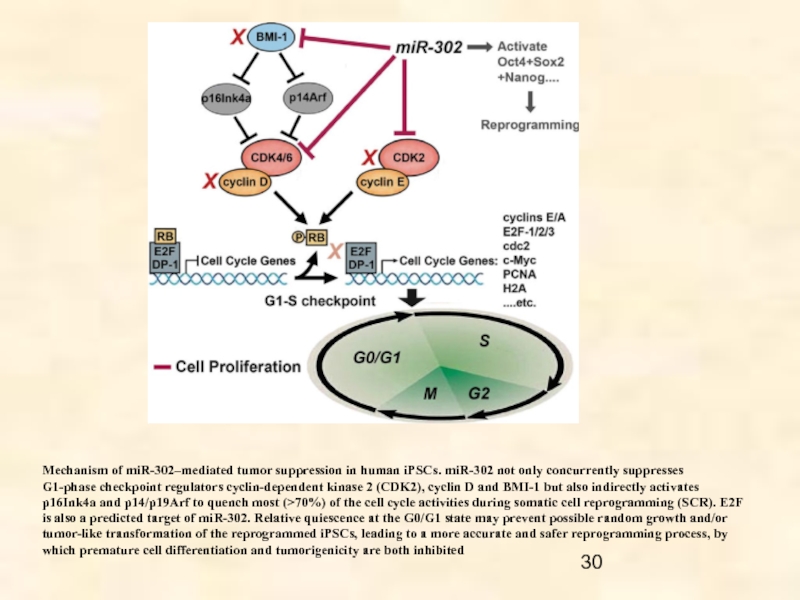

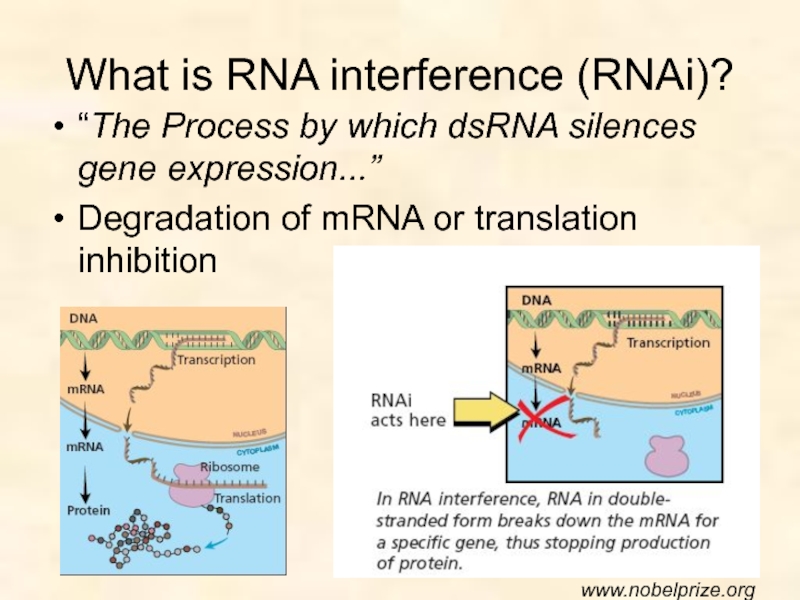
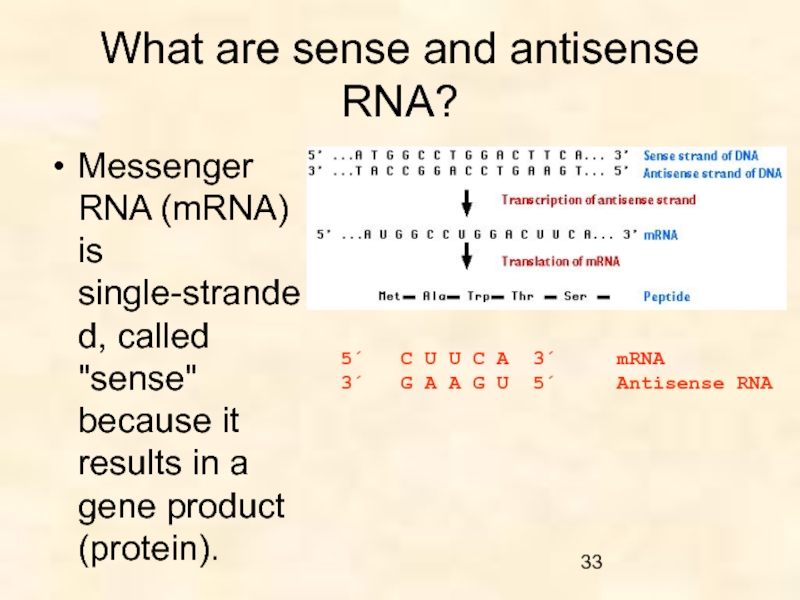
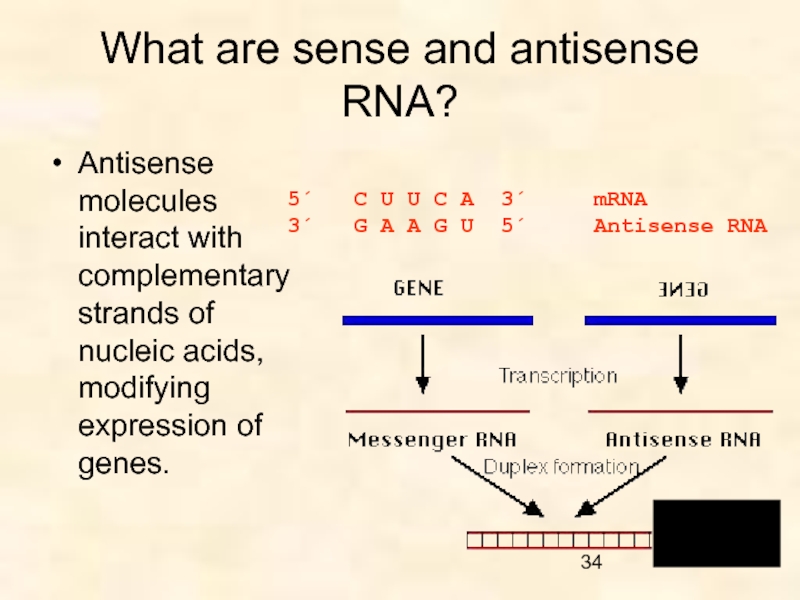
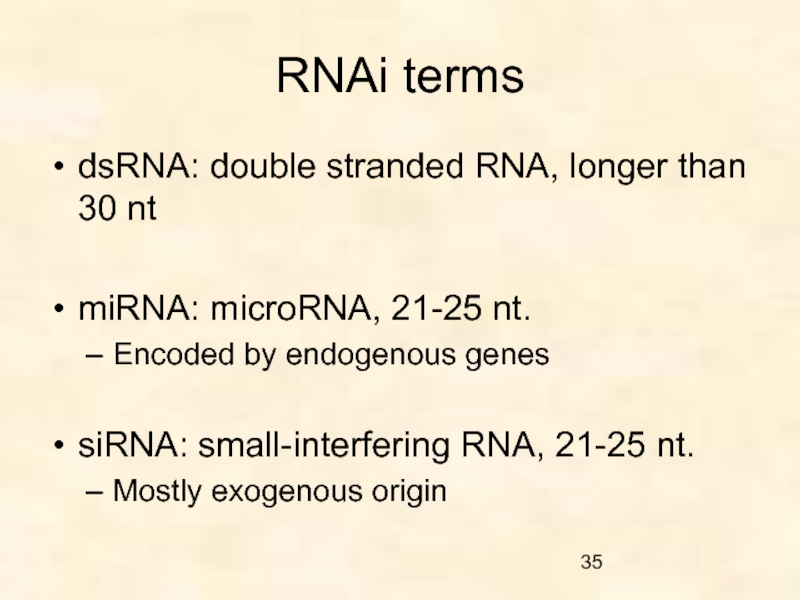
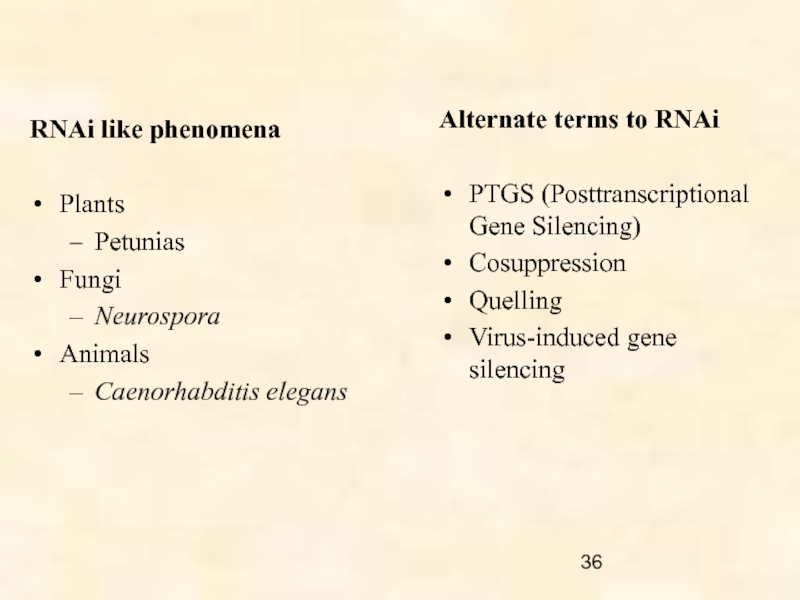

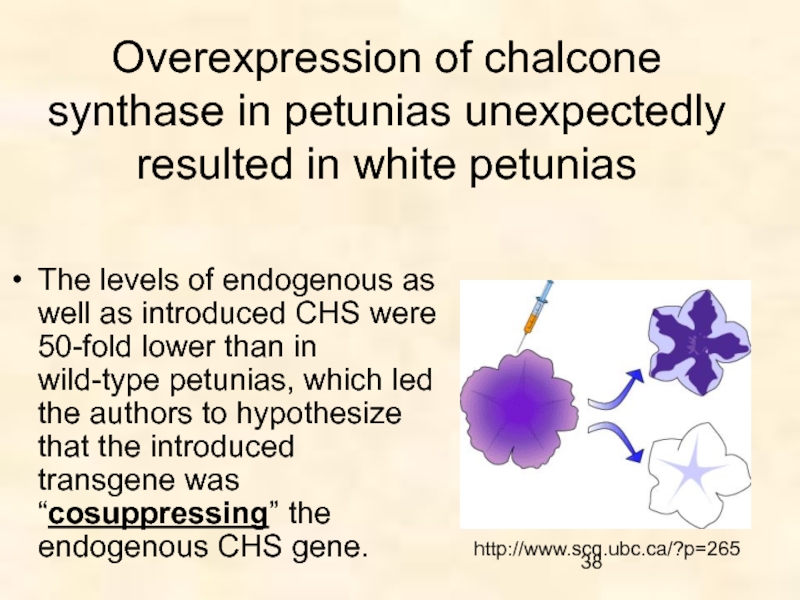
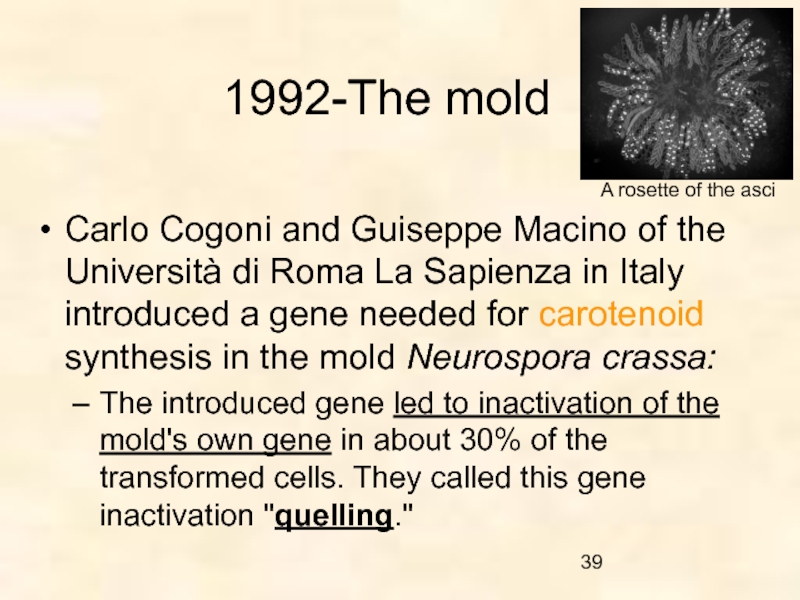

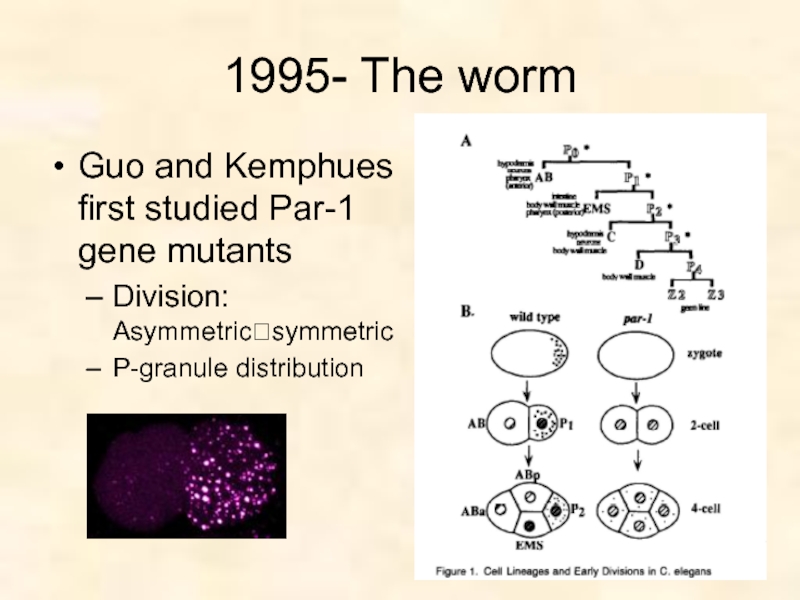
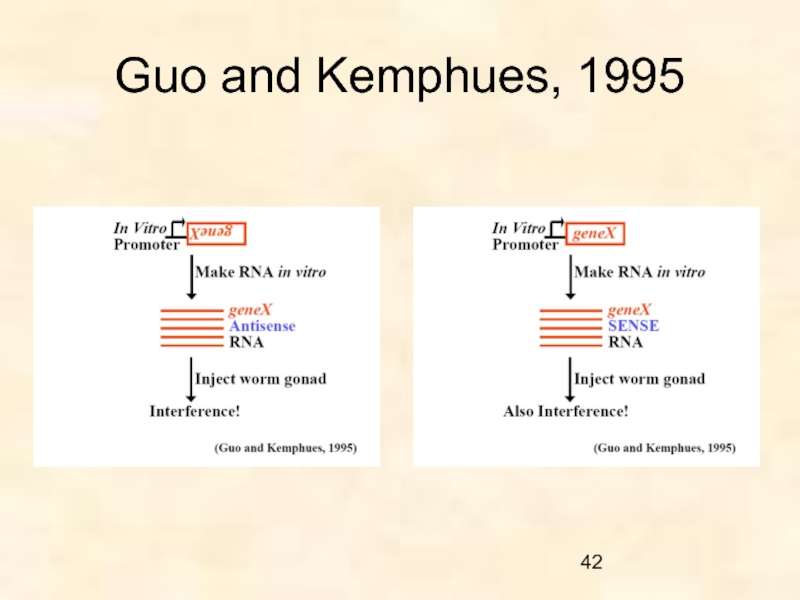
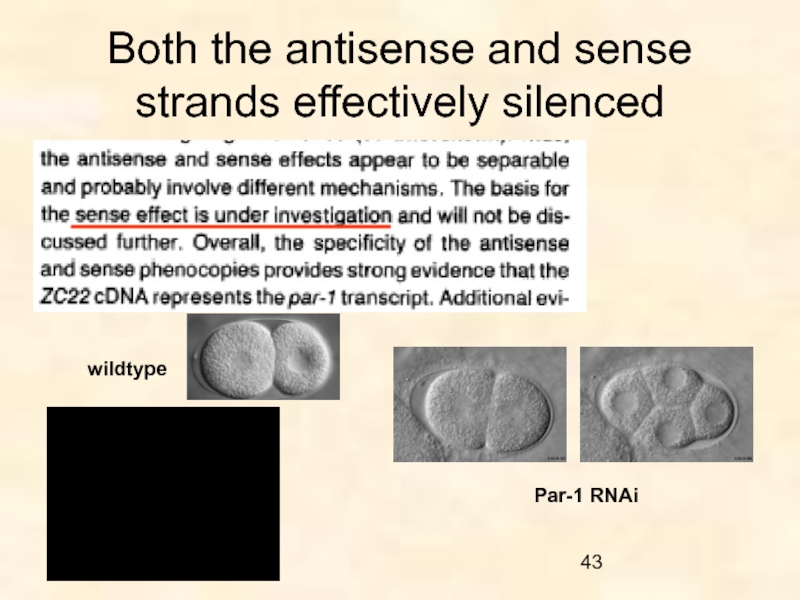
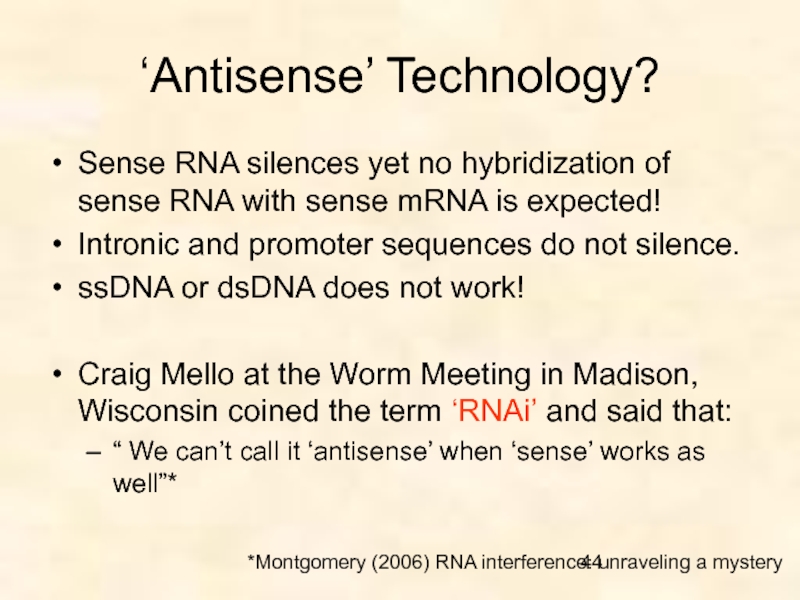
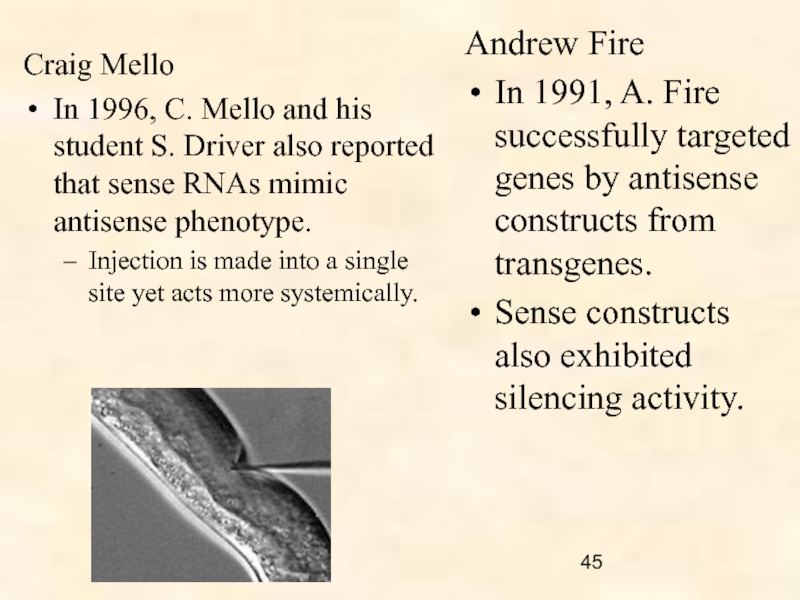
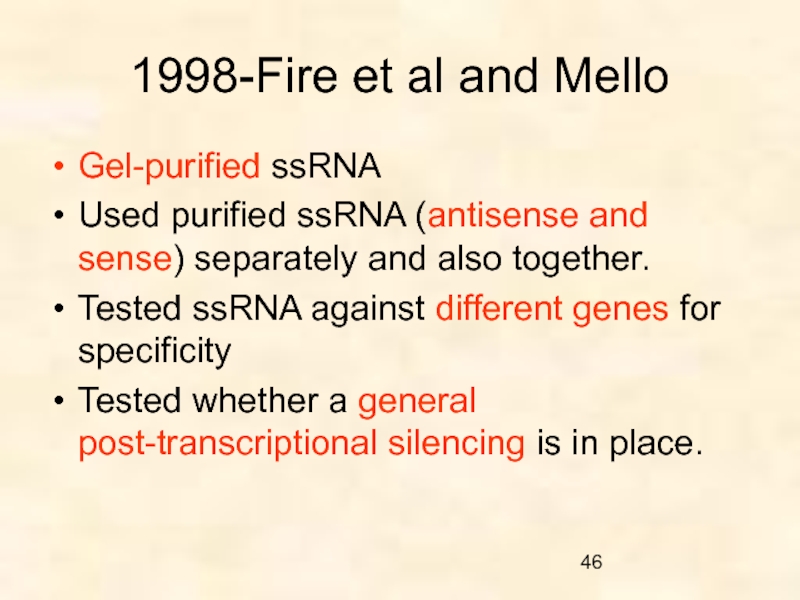
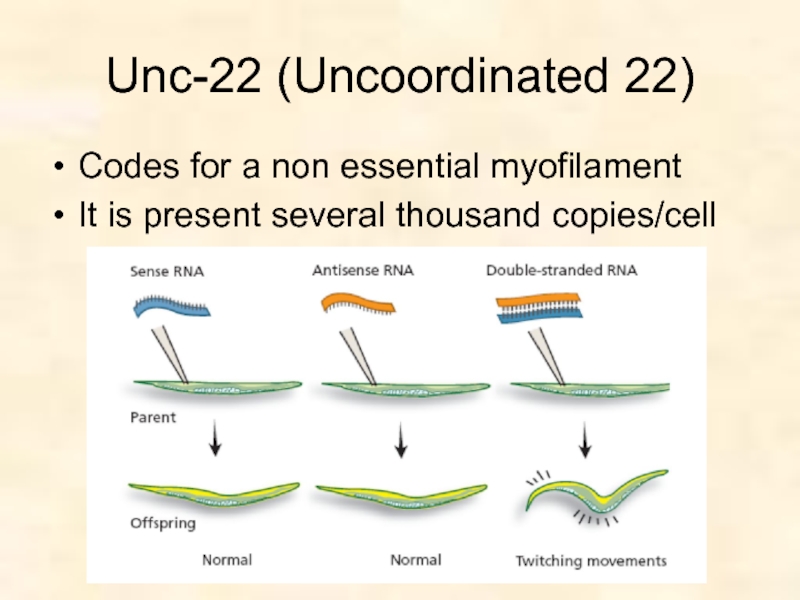
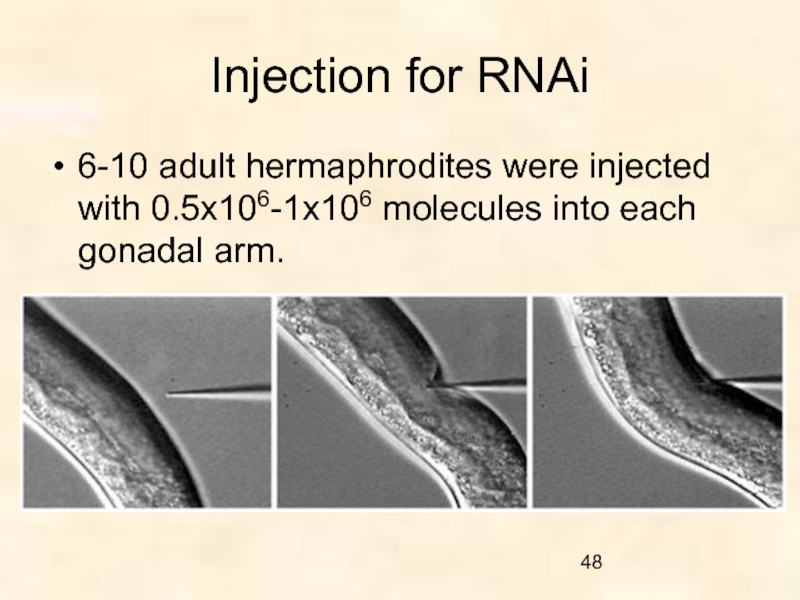
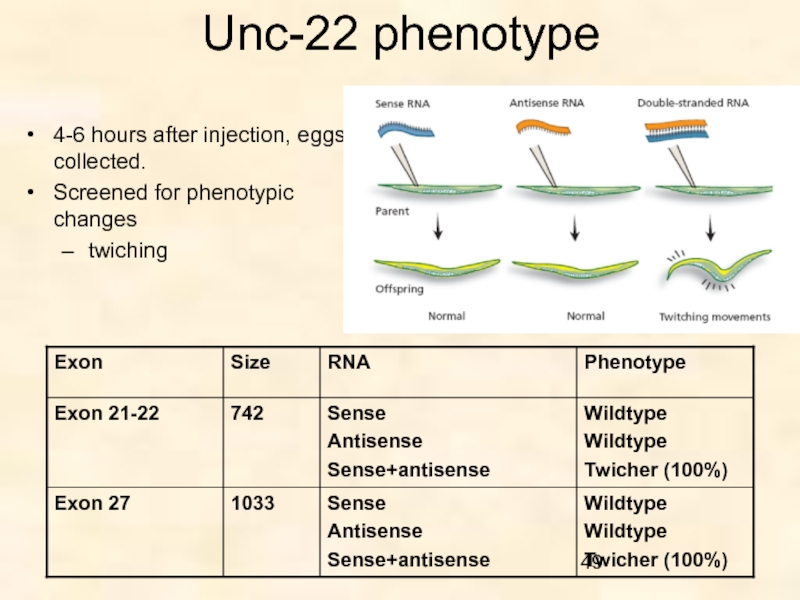
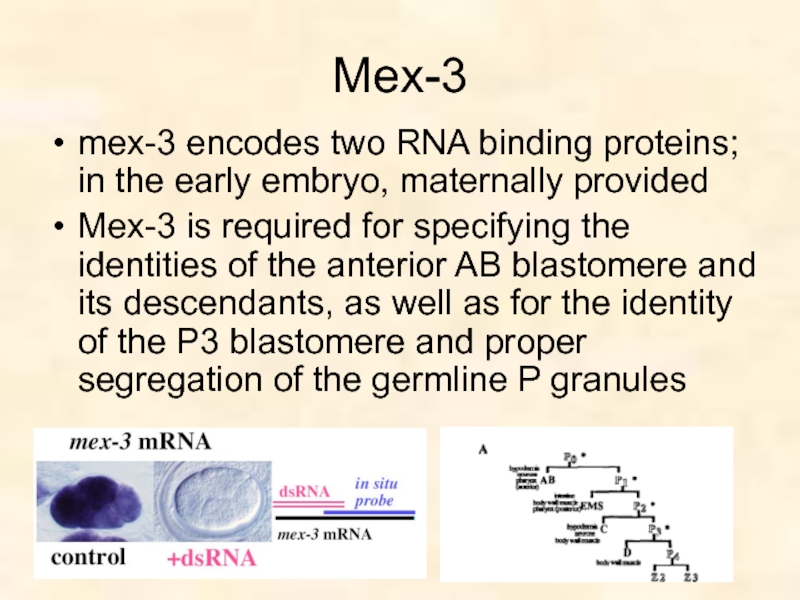
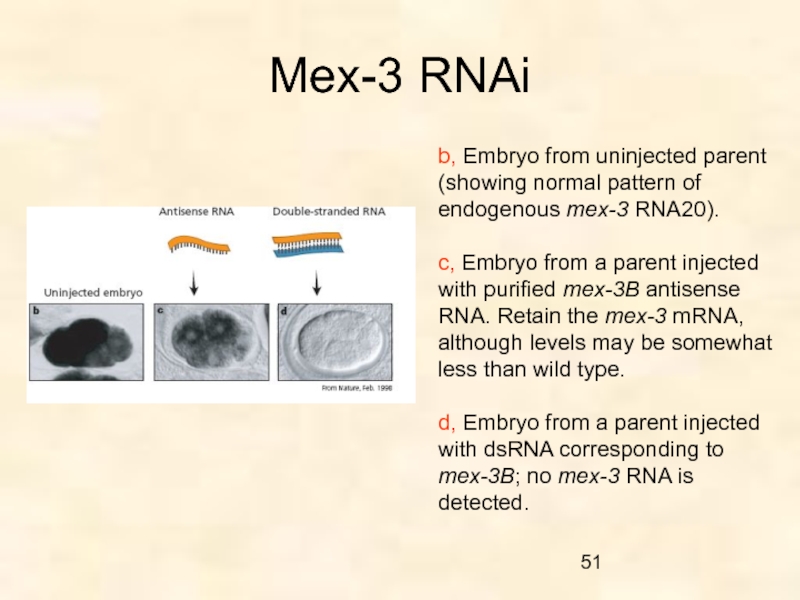
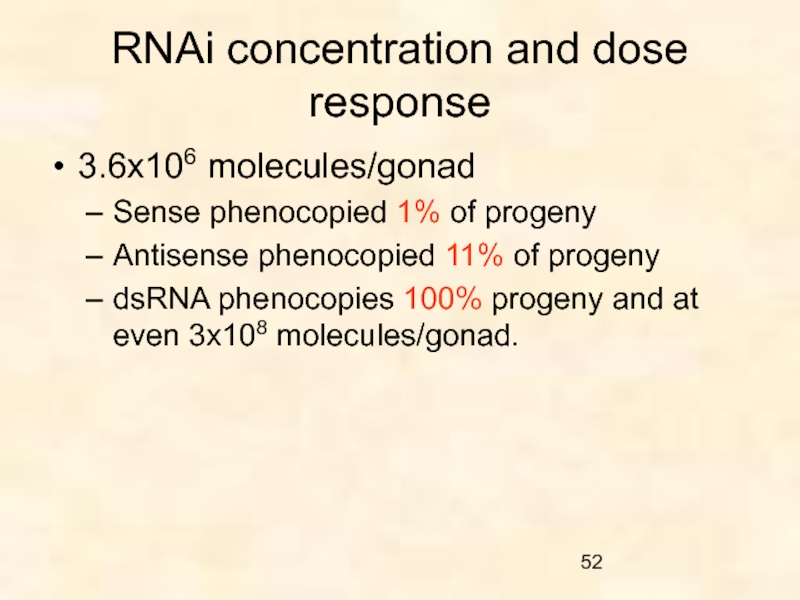
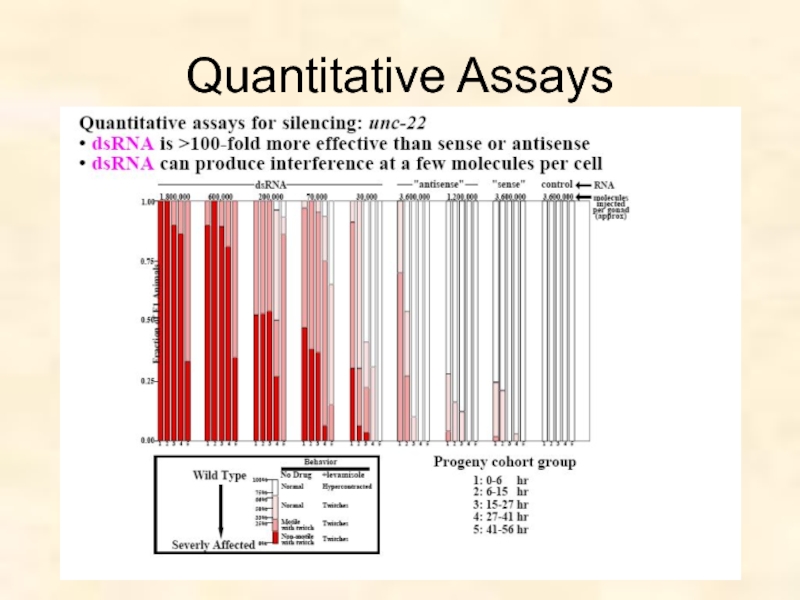
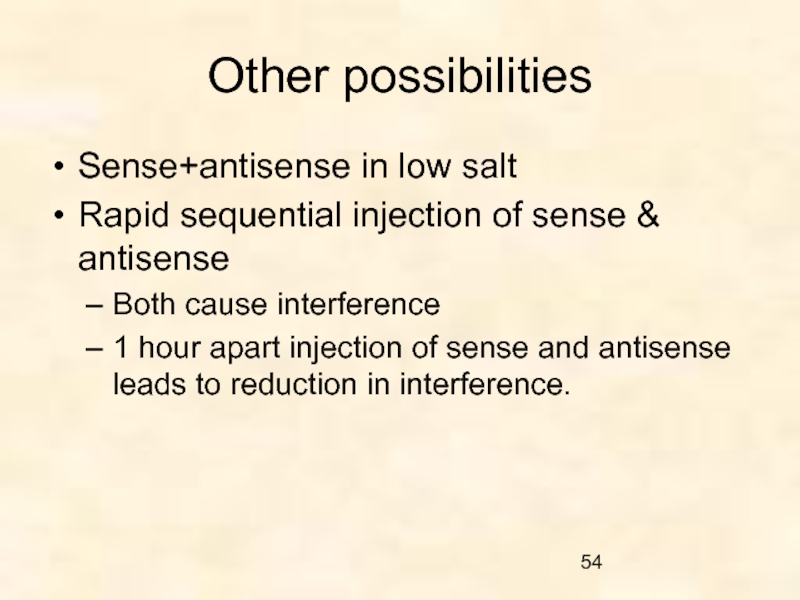
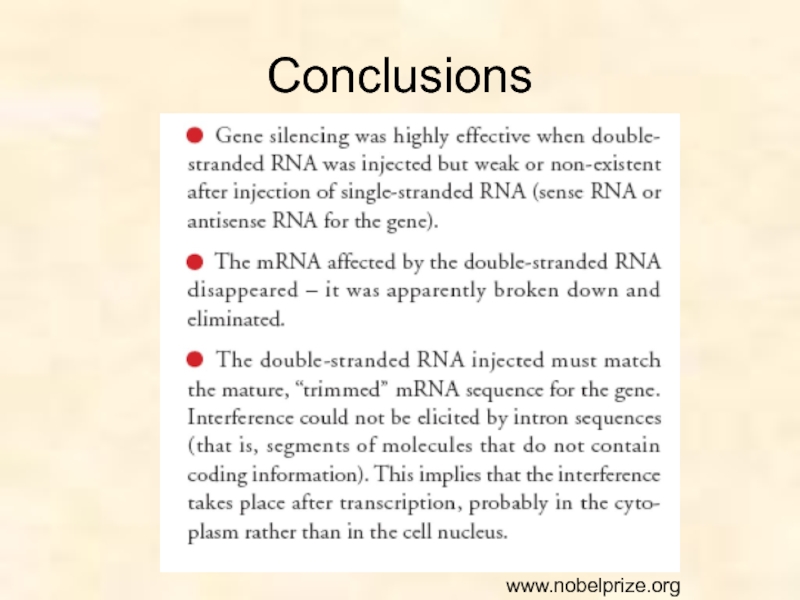
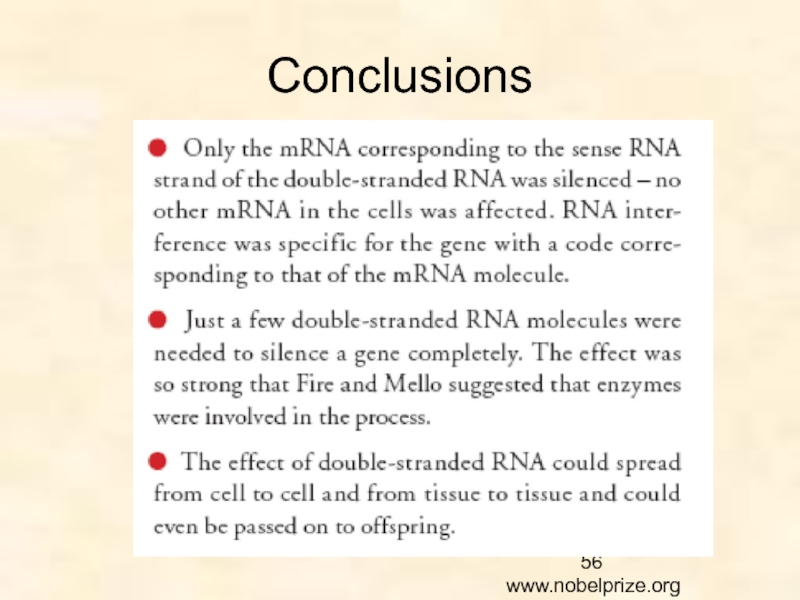
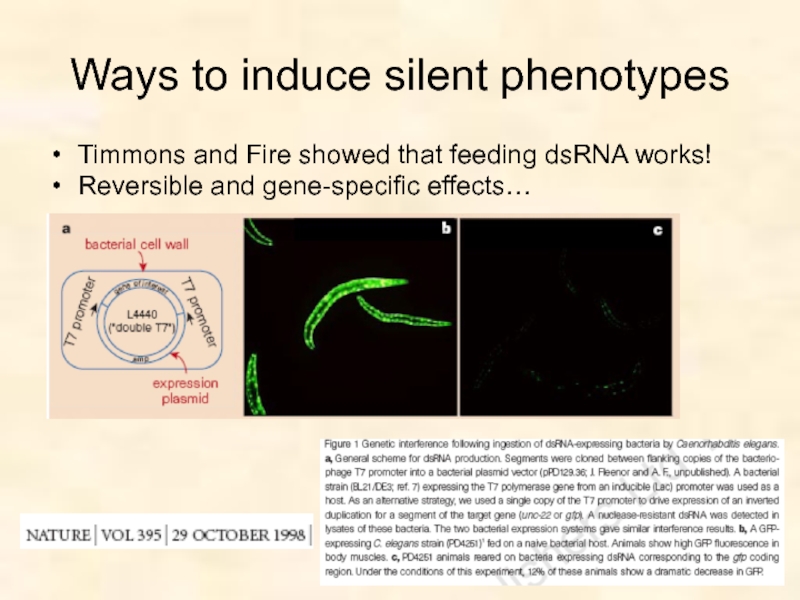
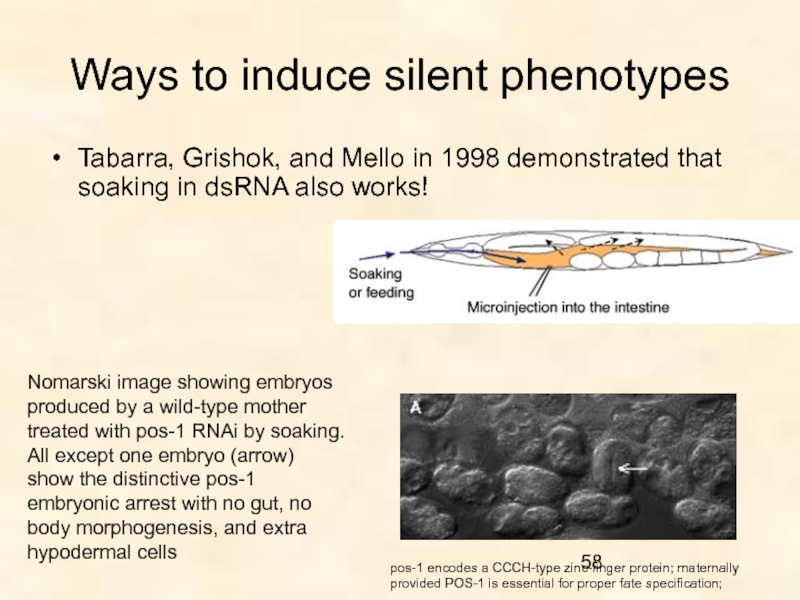
![Mechanisms revealed25bp species of dsRNA found in plants with co-suppression [Hamilton and Baulcombe, 1999]Sequence similar](/img/tmb/4/348181/23101c0d6d54bb67539b16360b99c81a-800x.jpg)
